When I was in Cambodia, I encountered a highly-educated German with a PhD in neuroscience and a Masters in physics. We only spoke for about 30 minutes or so but when he left his departing words were: “There’s no such thing as the collective unconscious.”
His comment seemed peculiar to me at the time because we had not spoken about Jung’s theory. The conversation had mostly been around about philosophy so I wasn’t sure why he mentioned the collective unconscious at all. Regardless, the German’s opinion appears to be shared by many other academics, albeit not all.
The parting shot also made me wonder what his understanding of the collective unconscious is. Of course, everyone is entitled to an opinion, but opinions are fundamentally based on existing knowledge and/or experiences. Still, you can only believe what you believe.
It is understandable that Jung’s ideas attract scepticism. The unconscious cannot be measured and his theory that symbols are innate and inherited was largely based on empirical evidence and years of providing psychoanalysis.
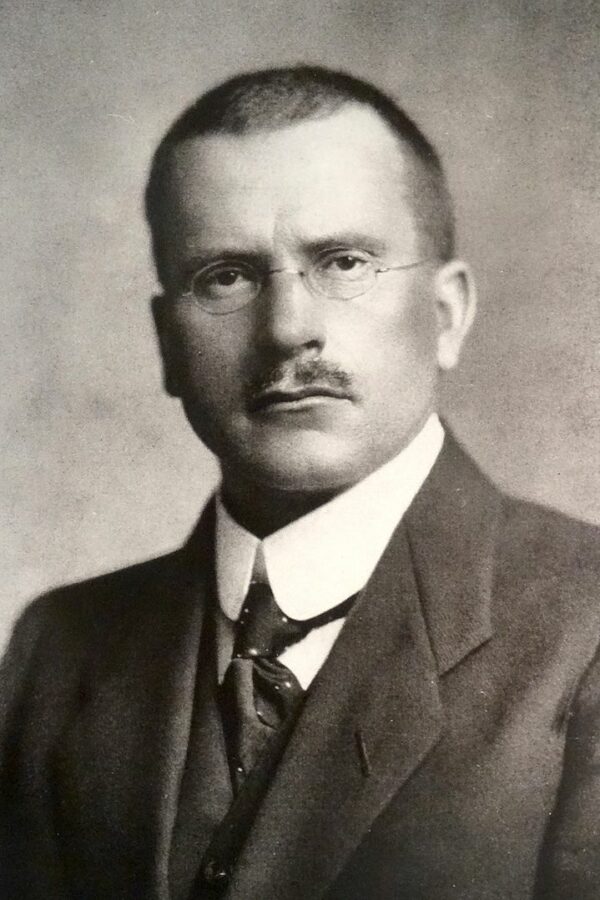
It should not be forgotten, however, that Jung’s interest in symbology enabled him to help a great many of his patients for which he earned a glowing reputation as a leading psychoanalyst. The inspiration he took from ancient symbolism also enabled him to write extensively on the topic of depth psychology and position him as a thought leader of modern psychology.
From my perspective, the concept of the collective unconscious has enabled me to understand some of the thoughts that appear in my conscious mind. It also explains weird experiences that cannot be explained by the concept of the personal unconscious alone.
Admittedly, my understanding of consciousness and the three aspects of mind has also been heavily influenced by the esoteric symbolism in ancient mythology, religious scripture and medieval alchemy.
My opinion is also based on personal experience. And I agree with Jung; consciousness appears to emerge from the personal conscious and a second source. This second source is what the eminent psychoanalyst called the collective unconscious.
Unless you have studied alchemy and psychology sufficiently enough to compare the similarities, it is difficult for a critical mind (especially a scientifically-oriented individual) to recognise the potential for a collective unconscious.
Having said that, my view on the collective unconscious deviates from Jung’s viewpoint somewhat. The only reason for that, however, is because recent advances in quantum science have made discoveries that go some way to explaining where the “second consciousness” may be coming from.
It’s not for me to force my opinion on you, nor will I try. On the contrary, you are free to form your own opinion and I encourage you to do so.
Nevertheless, in this article, I will discuss the various views about what the collective unconscious is, assess the criticism and finally give you a personal example of why there is a case for consciousness to arise from outside the personal unconscious.
In brief, the various points of views with regards to the collective unconscious are:
When trying to explain the collective unconscious, it is pertinent to understand the three aspects of mind;
I have explained the three aspects of mind in greater detail in the Beginner’s Guide To Symbolism but for the sake of clarity will provide a brief recap here.
The conscious mind contains thoughts and feelings you are aware of. For all intents and purposes, the conscious mind is how you relate to the world and experience what you perceive to be reality.
The personal unconscious is more commonly known as the subconscious. Content stored in the personal unconscious are programs that have been formed by information from the physical world that has been absorbed through the five senses.
Thoughts and experiences that are consistently fed into the personal conscious become concrete beliefs, attitudes, habits and personality traits. It is widely regarded that subconscious programs impact the experiences you have in life and can contribute to illness.
“The brain’s function is to co-ordinate the dialogue of signal molecules within the community. Consequently, in a community of cells, each cell must relinquish control to the informed decisions of its awareness authority, the brain. The brain controls the behaviour of the body’s cells.” ~ Dr. Bruce Lipton, Biology of Belief
The suprapersonal mind is likened to a force or energy that exists beyond the conscious and the subconscious mind. Jung refers to this aspect of consciousness as the collective unconscious which he said consists of archetypes that are common to all of mankind.
Some psychologists relate the suprapersonal mind to repressed emotions in the unconscious. For example, when people suffer a traumatic event, the brain shuts down to protect the conscious mind of the individual from experiencing the trauma.
This psychological process has been linked to patients that suffer from a dissociative identity disorder. Unless the trauma is healed and brought into the conscious mind, multiple personalities can develop and take control of the individual’s conscious mind.
Jung recognised this but also found that patients with any kind of neurotic behaviour suffered from some sort of dissociation. They did not have to suffer trauma but may have developed a belief that developed as a result of a poor relationship with their parents.
For example, a child from a broken family or alcoholic parents would not necessarily develop personality traits and unhealthy attitudes that prevent them from coping with life and nurturing positive experiences.

Perhaps the misunderstanding for why Jung meant by the collective unconscious stems from mainstream psychologists using both the subconscious and the unconscious to express the same thing. This can be confusing, and in my opinion, is wrong to do so.
For example, trained psychologists writing for Psychology Today describe the subconscious and the unconscious mind in the following ways:
”Subconscious: You dimly recognize that you feel a certain jealousy toward your teenage son. Yet you don’t know why. In reflecting about it, however, you begin to realize that where this feeling stems from is that (subconsciously) you begrudge the fact that he has so many more opportunities and privileges than you did at his age.” ~ Leon F Seltzer Ph.D (clinical psychologist)
“Unconscious: You have an aversion toward asparagus. The very sight of it makes you nauseous. Still, you have absolutely no idea why. What, because it’s been repressed, isn’t available to your consciousness is that when you were 6, your father insisted you eat this (new to you) vegetable on your plate, although you protested, for its smell back then was repulsive to you. But because you weren’t permitted to leave the table until you consumed it, after a fidgety hour you tried to shove it down your throat. . . and promptly vomited. Even worse, you got screamed at for the mess you made and told you were “disgusting.” ~ Leon F Seltzer Ph.D (clinical psychologist)
The example above comes from an article in which the writer is trying to distinguish between the subconscious and the unconscious. Notice here how the writer associates both the subconscious and the unconscious as storing information that is based on personal experiences.
This is, of course, a belief held by mainstream psychologists and not a Jungian belief. The mainstream view is that some repressed thoughts constitute the unconscious and hidden feelings surface from the subconscious even if that’s not what your conscious mind is thinking.
In my opinion, this view does not make a lot of sense. It is also very difficult for an individual to distinguish the origin of their thoughts and feelings. And if the patient can’t determine this, neither can the analyst.
Now read this example below:
“The subconscious is recognized as the source of creativity, intuition, inspiration, inner knowing, interconnectedness, and spiritual enlightenment. Within this realm reality shifts and expands, creating a matrix that is far more elastic and multi-dimensional than is perceived by the conscious mind. When we access and spend time within the subconscious we are released from the confines of our logical, practical mind. The messages we receive from our dreams and the primordial symbols, or archetypes handed down to us from our ancestors, inform us about what is unique, authentic, and sacred to each of us. When we heed these messages we are following the path of our soul’s evolution.” ~ Abigail Brenner M.D. (Psychiatrist)
There are a couple of points to note about his comment. Firstly, the description of the subconscious is completely different to the one above. Moreover, Brenner’s description of the subconscious is closely related to Jung’s collective unconscious.
These are not isolated cases I have picked out here. In mainstream psychology, there is a lot of confusion about which content surfaces from the “subconscious” and which come from the “unconscious”. Moreover, this model could be excluding an important aspect of consciousness we need to know about – one that cannot be measured scientifically; the True Self – missing traits and wisdom we need to develop to become whole.
The example below is not assigned to an author but nevertheless is an explanation given on the Psychology Today website. Again, the description of the “unconscious” is essentially how Jung described the personal conscious.
“Researchers know that the unconscious mind does the lion’s share of the brain’s work, but they don’t know exactly how all of it gets done, and it is an active subject of study. For example, one major area of research is how emotions take shape in the unconscious. Information is stored associatively in the brain, which is largely bundles of pathways of association—far too many to remember, but usually responsive to activation when needed.” ~ Psychology Today International
Another example on Psychology Today has this to say about the Unconscious:
“…to better understand your unconscious, it’s fundamental that you grasp that this is the part of your being that represses extremely unpleasant memories, or hides them away from you. As one author puts it, it’s that aspect of mind which “includes socially unacceptable ideas, wishes and desires, traumatic memories and painful emotions that have been repressed.” Again, in that self-regarded moment of crisis you hadn’t yet developed the ability to effectively deal with what was felt as gravely threatening your welfare.”
Again, the description alludes to personal experiences and traumas that have been repressed because the conscious mind could not deal with the experience as it happened in that moment.
The above opinions, as is the case with the majority of mainstream psychologists, are based on Freudian theories. Jung’s view of the unconscious, on the other hand, separated the unconscious into two separate parts, one of which supports the conclusion that the personal mind is comprised of information we have gathered from life experiences and another which originates from a metaphysical realm that exists beyond the body.
“The collective unconscious is a part of the psyche which can be negatively distinguished from a personal unconscious by the fact that it does not, like the latter, owe its existence to personal experience and consequently is not a personal acquisition. While the personal unconscious is made up essentially of contents which have at one time been conscious but which have disappeared from consciousness through having been forgotten or repressed, the contents of the collective unconscious have never been in consciousness, and therefore have never been individually acquired, but owe their existence exclusively to heredity. Whereas the personal unconscious consists for the most part of complexes, the content of the collective unconscious is made up essentially of archetypes.” ~ Carl Jung, The Archetypes and the Collective Unconscious
It is this second aspect of the unconscious that Jung called the collective unconscious. But because of its mystical nature, his theory is often criticised.
In the Beginner’s Guide To Symbolism, I discuss Freud’s model of the mind and show why his theory is problematic. As we can see from the comments above – on what is supposed to be an authoritative website – that Freud’s model has caused significant confusion.
In my mind, it makes sense that there is a second source of consciousness which lays outside the personal unconscious. Thus the subconscious and the unconscious should be divided into two distinct parts. In doing so, it is far easier to understand which part of your conscious thoughts are arising from; the conscious mind, the personal conscious (ego) or the collective unconscious (Self).
However, as you can see from the diagram below, both sources of conscious intermingle with one another and influence conscious awareness. This model is closer to Jung’s and, in my mind, helps me to figure out which repressed emotions need releasing or which aspect of my personality needs balancing.

Jung’s theory of the collective unconscious hinges on his belief that the deep recesses of the mind contain archetypes. He described archetypes as signs, symbols, or patterns of thinking and behaving that are common to all human beings.
His theory explains that undeveloped aspects of consciousness remain in the unconscious and project on to the ego. Such projections make us act instinctively and oftentimes “out of character”.
The ego is the centre of conscious awareness that interacts with the outside world. The archetypes are aspects of the human psyche that belong to the inner world and project themselves on to the ego so the individual becomes aware of thier missing aspects.
When an archetype projects they can possess the ego and drive moments of madness, erupt in anger, cause you to make mistakes, make you irritable and moody, and even create accidents.
“We can hardly get round the hypothesis that an emotionally charged content is lying ready in the unconscious and springs into projection at a certain moment.” ~ Carl Jung, The Archetypes and the Collective Unconscious
The idea of projection is not uncommon in mainstream psychology even though the concept of the collective unconscious is generally dismissed.
On the other hand, the analysis of dream symbolism is common practice for other psychologists – especially Jungians. I have also found that interpreting symbols that appear in dreams – and in everyday life – can help steer clients towards self-realisation.
The principle reason for people to dismiss Jung’s collective unconscious is because of its correspondence with spiritual beliefs. The collective unconscious can be likened to the Cosmic Mind, Supreme Consciousness, Brahman and Akashic Records for example.
Jung also believed symbols and motifs that appear in dreams or thoughts of individuals are inherited from ancestors and that we are born with them in our unconscious realm.
This conclusion shares the common theme of reincarnation that is apparent in organised religions. However, Jung was not religious but rather believed ancient scriptures were an attempt to describe the psychological phenomenon present in all mankind regardless of culture.
“Jung, who construed alchemy as an age-old method of psychological transformation clothed in the terminology of metalwork…the main thrust behind Jungian psychology is that all occult and religious phenomena are psychological in nature and are connected to the relationship between the individual and the realm of the collective unconscious. The primary inhabitants of the collective unconscious are the archetypes – pre-existent ideas or basic categories of human awareness. They are centres of psychological energy that tend to surface in human consciousness through similar forms and images. These images are timeless and universal.” ~ Israel Regardie, Gold
Another way to explain the collective unconscious is an inner-knowing that appears as thoughts, intuitive feelings, instincts and images. Moreover, Jung surmised the gods, characters and magical objects in mythology were archetypes that are common among humans and thus we can learn about ourselves by analysing the symbols that appear in dreams and everyday life with events happening in our lives at certain moments.
“What makes alchemy so valuable for psychotherapy is that its images concretize the experiences of transformation that one undergoes in psychotherapy. Taken as a whole, alchemy provides a kind of anatomy of individuation. Its images will be most meaningful, of course, to those who have had a personal experience of the unconscious.” ~ Edward Erdinger, Anatomy of the Psyche
Jung believed that symbols contained in dreams had a universal meaning that shares similar things to different people. Essentially, they reflect traits that are inherently human nature.
Although we are largely unaware of contents in the collective unconscious, when habitual programs are holding you back, unconscious archetypes come into play and project themselves on to the ego. When this happens, it is an indication there is something you can learn about yourself.
Whenever a thought leader introduces a theory that goes against the grain of the accepted paradigm, it is typically dismissed. When Charles Darwin’s theory of evolution was announced at the Royal Academy of Arts, it was reported the general consensus was ‘that idea will never take-off’.
There are many examples of scientific and medical theories that were criticised at the time that turned out to be right.
The opposite is also true. Multiple theories that were accepted for years turned out to be incorrect. The church’s belief that the earth was the centre of the Universe is a prime example. Newton’s universal law of gravitation was accepted for over 200 years before Albert Einstein’s Theory of Relativity shows objects curve the fabric of space and time around them.
It’s no surprise that Jung’s collective unconscious is subject to ridicule within the scientific community. I have outlined the criticism below and will discuss both sides based in their merits.
Jung had a deep interest in alchemy and was knowledgable about Christain traditions together with oriental religions, particularly Chinese philosophy. He drew heavily on ancient texts to help him interpret the dreams of his clients.
Moreover, Jung recognised that symbols appearing in the dreams of his patients were also found in mythology. This conclusion led him to the idea of the archetypes which he presumed must arise from the unconscious. He also encountered patients that had visions that could not have come from the personal conscious, thus he felt symbols must arise from an ancestral memory.
Critics reference Jung’s source material to belittle his theory of the collective unconscious. He was accused of disrespecting scientific enquiry.
Even Jung’s work with indigenous groups such as the Pueblo Indians of North America, together with his interest in occult and religious symbolism has been derided as pseudoscience. Critics, including Freud, felt this connection was taking him further away from psychoanalysis.
It is understandable that academia would consider a theory inspired by archaic stories are considered mystical rather than scientific. It is impossible to challenge this claim. However, who’s to say that mysticism is closer to an understanding of nature that materialist science?
An understanding of symbolism reveals secrets about consciousness that modern scientists cannot explain because consciousness cannot be measured.
That is a matter of opinion, of course, but the concept of mysticism in modern thought gives rise to the idea spiritual or occult experiences that are linked with “foggy, confusion and vague thinking. ” (William Stance, Mysticism and Philosophy). There is a perception, therefore, that mystical experiences relate to magic, miracles and hocus-pocus.
However, ancient mystics considered their work as sacred sciences. They studied nature to understand themselves and the world around them. They were also much closer to their unconscious than the modern man with all our distractions and brainwashing.
Fortunately, some members of academia believe consciousness is worthy of exploration. The discoveries they are making fall in line with some of Jung’s theories that constitute the collective unconscious. So is the inspiration the Swiss psychoanalyst took from ancient mysticism so irrational?
Counter argument:
This criticism is, of course, a matter of opinion. Subsequently, it’s barely worth discussing as counter-argument because my feeling on ancient wisdom is the same as Jungs. You either see it or you don’t.
Jung’s theory for the collective unconscious arose from his understanding that some thoughts and feelings are not shaped by personal experience. His conclusion was that the deepest part of the unconscious mind must be inherited.
There are two ways to look at this; Lamarckcism and reincarnation.
The French naturalist and biologist proposed that individual characteristics passed down from generation to generation through genes. Jung also proposed that symbols in the collective unconscious were ancestral – or what Freud termed as ‘archaic remnants.”
Lamarck also proposed the idea that genes can be reshaped by information acquired from the environment. In short, experiences program a cell’s genes. His theory was considered radical and by the mid-1930’s hard completely fallen out of favour among academia.
Despite the new discoveries, some scientists persist with the materialistic view that the genes passed down by our parents stay the same our entire lives. But not every adult is like their mother, father or even siblings. Lamarckism seems to be a much more appropriate explanation for this than Darwinian randomness.
Experiments to investigate the collective unconscious would be very difficult to prove scientifically because the unconscious absorbs 11 billion bits of data per second. This is compressed into less than 50 billion bits for the conscious mind to absorb.
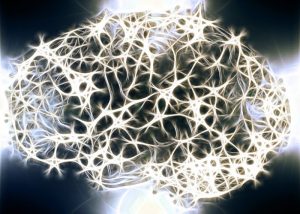
It would be very difficult for scientists to establish which content had been pushed into the unconscious and would take decades to perform such a study. Yet modern psychology recognises that experiences and emotions repressed in childhood do impact on our adult lives.
With this in mind, it is clear that information in the personal unconscious is repressed or suppressed. Moreover, it explains why psychologists typically label the unconscious and the subconscious as the same thing. It also provides a valid reason to completely dismiss the collective unconscious on the grounds the idea is “mystical fantasy.”
Critics do have a point here.
The question has to be asked whether thoughts and symbols we cannot relate to actually come from personal experiences or is the information stored in our genes?
For example, a comment left on a psychology website, Good Therapy provides an example of how people may perceive their experiences as a by-product of the collective unconscious but could be genetic:
“I majored in Psychology in the late ’70’s/early ’80’s and of course, I studied Jungian theory amongst others. I also minored in Dance, since I started at 5 years of age. But it was during my dance experience during college that I began to experience chills when watching certain formal dancers but especially African Dancers and Drummers. I started seeking information about my physical reaction to something visual, and I remembered my studies regarding the Collective Unconscious. Jung’s theory about that made perfect sense to me as to why I continue to have physiological responses to African performers in particular, and formal dancers in general. Oh, by the way, I am an African American female.”
The writer clearly believes in the concept of the collective unconscious. She also had me convinced until she revealed she had African origins. Subsequently, genetics could account for her dance experiences. Although African music may not have been personal to her, a distant memory could exist in her unconscious mind.
Jung was convinced that consciousness arises from a second source and interacts with both the subconscious and the conscious mind. Moreover, he was adamant that it could not be attributed to information gathered by sense perception.
We know that genes in DNA are passed down from our parents. Could the information in genes be memories of the distant past and remained unconscious in the family for generations?
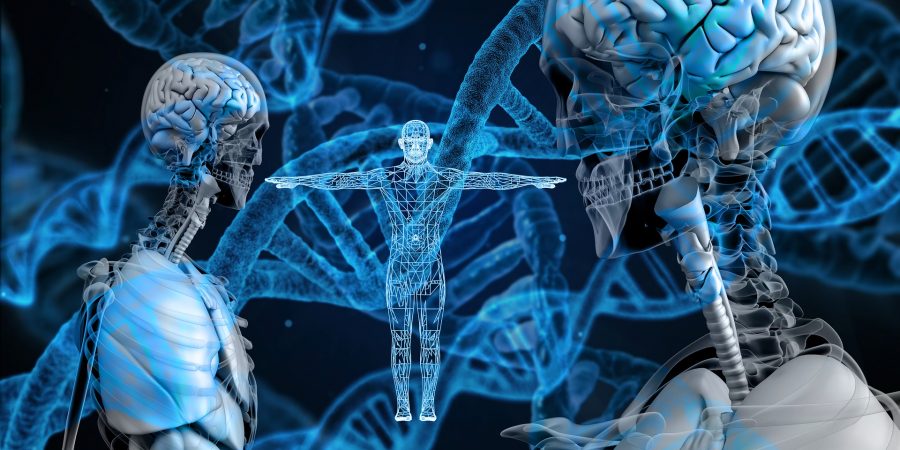
This is one view held by science that does have some logical grounding. It would also give scientific meaning to Jung’s “mystic” and “irrational” theory. Regardless, the fact of the matter is that criticism is always a matter of opinion.
Having said that, genetic inheritance does not explain some of the personal experiences I have had. But more not than later. I have a third theory, but before then, let’s discuss the second viewpoint for what Jung’s collective unconscious receives so much criticism.
From his writings, it is clear that Jung bought into the idea of the “soul” which is why his theory of the collective unconscious is derided as mystical fantasy. It is easy to assume the Swiss psychoanalyst perceived the idea of the collective unconscious from ancient wisdom which proposes our souls reincarnate many times.
Personally, I do not have an experience that I can relate to which categorically makes me believe reincarnation is a genuine experience. Having said that, I have met plenty of people that have, including my sister, Michelle. As far as I am concerned, none of the people I have spoken to about their past life experiences had anything to gain from telling me their story so why would they lie.
I certainly believe my sister because prior to her near-death experience, she would not have believed in anything mystical never mind reincarnation and past lives.
It’s obvious that Jung’s idea for this second source was heavily influenced by alchemy, Gnosticism, and the various Asian traditions. Closer inspection also reveals these cultural disciplines penned by ancient sages relate to psychology.
In Hinduism, for example, the concept of atman (the individual soul) and Brahman (the Supreme Intelligence) shares correspondence with Jung’s personal unconscious and the collective unconscious. Similarly, the gods of mythology share correspondence with the archetypes.
It’s worth noting that the “soul” is an ancient word for the subconscious. If you read any mystical writing and replace the word soul for the subconscious, they say the same thing. Take the paragraph below for example:
“The only means of overcoming limitations is to develop further the life of the soul. That’s when we discover the reason why we could not move from one thing to another is because of our own soul. We learn that “sight” of the supersensible world differs from perception in the world of the senses.” ~ Rudolph Steiner, Road To Self Knowledge
The inability of Jung’s critics to see beyond the personal conscious is because it cannot be measured by scientific reasoning.
However, in recent years, quantum scientists have shown that particles in atoms can communicate with one another over vast distances. The findings support quantum entanglement, which in essence, shares similar characteristics of the collective unconscious in that it explains how information stored in atomic particles communicate with one another.
What’s more, we know the world consists of an electromagnetic field which is made of atoms. The human body is also comprised of billions upon billions of atoms. So if particles in atoms can communicate with one another, you don’t need to stretch the imagination too far to assume that maybe, our thoughts become entangled with a particle which replies by way of thought.
Thoughts are energy, thus when we have a thought it emits a wave and integrates with the electromagnetic field we are all connected to. Science shows that when a wave moves, it carries matter, energy and information to different places.
When you apply this scientific discovery to mysticism, it provides an explanation for how the “atman connects with Brahman” in Hindu traditions or how God is omnipotent, omnipresent and omniscient.
As I explain in the Beginner’s Guide to Symbolism, God is consciousness and consciousness guides energy.
The Quantum Physicist, Dr. Rulin Xiu writes:
“Soul is the content of the information in everyone and everything. Heart includes the physical heart and the spiritual heart. The spiritual heart is the receiver of the information in everyone and everything.” ~ Dr Rulin Xiu: Tao Science: The Science, Wisdom, and Practice of Creation and Grand Unification
Jung’s belief that we are born with a pure consciousness also seems feasible despite its relationship to spiritual thinking. It makes sense that the personal unconscious will be empty until we absorb information through the five senses.
Moreover, it explains intuition, thoughts that seem to appear from nowhere and those weird experiences that cannot be attributed to contents that would naturally exist in your personal conscious. (I give an example of a personal experience below. I suspect you have your own).
Jung certainly had his own experiences of paranormal phenomena and thoughts he could not explain. But it was the countless occasions in which he encountered patients that had experiences and visions of images that were alien to them that convinced him there was a deeper unconscious source that pervaded the mind of mankind.
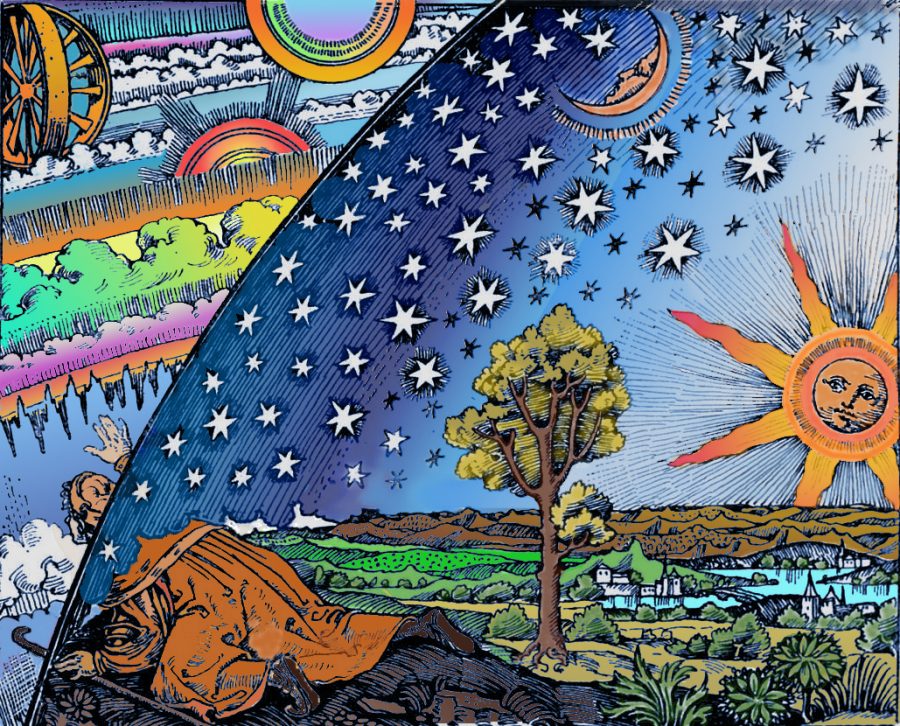
Critics argue that inspiration for new ideas can be developed through cultural reference, personal experience and imagination. It’ a fair point that has rational merit.
However, the mainstream explanation does not take into account Jung’s experience in which he treated patients that dreamt symbols they could not have been exposed to.
In Man and His Symbols, Jung gives an account of an eight-year-old girl that drew illustrations of images she had seen in her dreams. Her concerned father took the diagrams to Jung because they were “wholly incomprehensible” to him. The girl’s father claimed his daughter had never been exposed to such images.
Jung also described the diagrams as “the weirdest dreams” and deduced the symbolic images could not have emerged from the girl’s personal unconscious. Unfortunately, the girl died before Jung was able to speak with her in person and explore her dreams in greater depth.
The Swiss psychoanalyst also gives an account of an educated professor that came to him after dreaming of a symbol he could not associate with. The professor thought he was going insane. Jung explains:
“I simply took a 400-year-old book from the shelf and showed him an old woodcut depicting his very vision. “There’s no reason for you to believe that you’re insane,” I said to him. “They knew about your vision 400 years ago.” Whereupon he sat down entirely deflated, but once more normal.”
Our views of the world are merely perception. You will believe what you believe based on your own experiences. Jung did and so did his critics. Moreover, Jung claimed his critics simply didn’t understand his point of view because they viewed the world in a different way and thus misunderstood his ideas.
“My views about the “archaic remnants,” which I call “archetypes” or “primordial images,” have been constantly criticized by people who lack a sufficient knowledge of the psychology of dreams and of mythology. The term “archetype” is often misunderstood as meaning certain definite mythological images or motifs. But these are nothing more than conscious representations; it would be absurd to assume that such variable representations could be inherited.” ~ Carl Jung, Man and His Symbols
Jung was not the only psychoanalyst to make a connection between ancient mythologies and human consciousness. In actual fact, he originally got the idea from an early student of Freud, Herbert Silberer. Like Lamarck, Silberer was another thought leader that was ridiculed. Having been ostracised by his peers, he committed suicide.
In the 1930s, the German Philosopher and psychoanalyst Erich Neumann was also explaining the unconscious by drawing on knowledge given in ancient texts. To be fair, Neumann was a student of Jung and undoubtedly influenced by his tutor. Nevertheless, he recognised the connection between symbolism and human psyche.
It is clear to see from Neumann’s writing that he recognised consciousness comes from outside the body. Thoughts and instincts that project on to the ego do not always originate from the personal conscious.
“We have already spoken of the sudden emergence into consciousness of an idea as an original spiritual activity of the unconscious. The penetration into consciousness of spiritual contents, endowed with the character of intuitive cogency, and their capacity to dominate it, is probably the original form in which the spirit appeared to humankind. While an expanding consciousness and a strengthened ego introjects these emerging contents and understands them as an internal manifestation of the psyche, they originally appear to the ego “from outside” as sacred revelation and as numinous messages from the powers or the gods. Even if it calls them intuitions or inspirations, the ego that experiences these contents coming from without assumes a receptive stance vis-a.-vis the spontaneous phenomenon of spirit, a stance characteristic of matriarchal consciousness.” Erich Neumann, The Fear of the Feminine
Research in the area of consciousness verifies the theories of Jung and Neumann. It was originally believed that consciousness resides somewhere in the cortex but researchers have not been able to pinpoint where.
Panpsychism also alludes to the idea that consciousness pervades the universe. The theory holds that “everything in the physical world—all subatomic particles-are in some sense ‘conscious’ or have a basic kind of ‘proto-consciousness”.
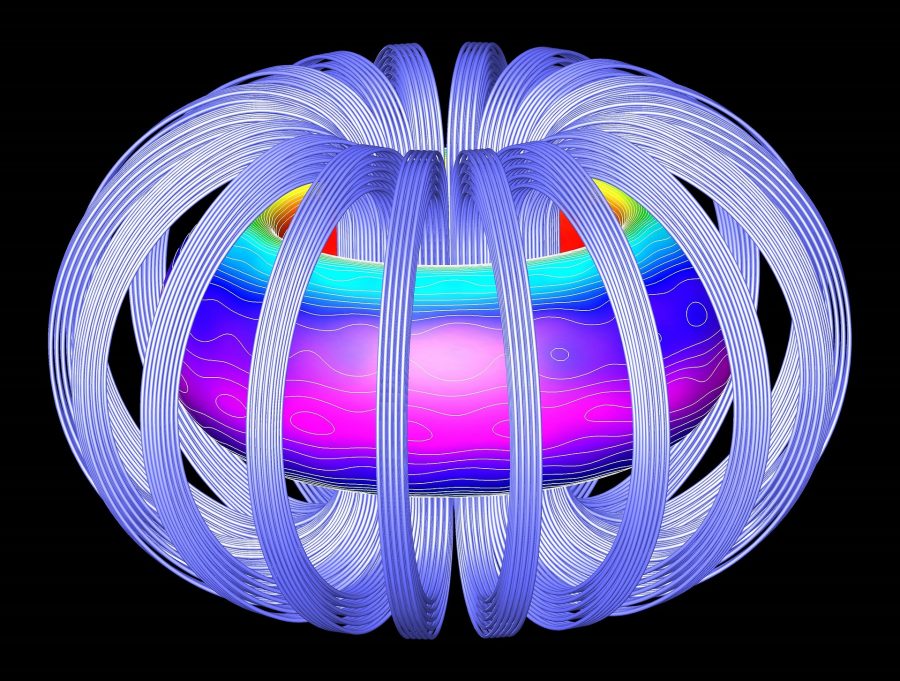
Another body of scientific research known as Neorealism suggests consciousness is a cross-section of the environment and exists outside the brain.
“Brain-centred theories of consciousness seem to face insuperable difficulties. While some philosophers now doubt that the hard problem of consciousness will ever be solved, others call for radically new approaches to conscious experience.” ~ Cambridge Center for Behavioral Studies
In other words, consciousness emerges from both within and outside the body.
On a side note, I originally found this quote whilst researching consciousness in 2017. When I looked for a source to link to from this article, the quote has been completely eradicated from Google search results.
I will leave you to determine why.
Critics argue that Jung’s definition of archetypes is vague and cannot be researched or demarcated with any kind of rigour. At best they are personality type. Subsequently, they are used as such in psychology today. The problem with this is process is it boxes people into a dominant personality, but it is the other personalities that we have to develop.
Synchronicity is dismissed on the grounds that is cannot be supported by scientific data. It is thought that synchronicity undermines the respectability of science as a discipline, promotes superstition and rekindles polytheistic ideas that fly in the face of the monotheistic Catholic tradition.
Counter argument:
Synchronicity may not be testable but it can be proven on empirical evidence. How many times have things simply fallen into place for you? Everybody has a story to tell about synchronicity at its finest.
For example, I have never met anybody that has pondered over a question or problem and not have the answer “miraculously” appeared several days later? Some would argue that answers do not appear every time and this is true to a point.
In my view, the answers do appear but the conscious mind is not aware of it in the moment. There have been times when I registered the answer, ignored it and only realised it was right there a few days later. The answer may be staring you in the face but you miss it because ego-consciousness rejects it. The information sinks back into the subconscious but comes back with greater force until you “learn from your mistakes”.
In his book ‘The Power of the Subconscious Mind’, Dr. Joseph Murphy explains how the subconscious engineers your desires so that the things you need fall into place. Like Jung, Murphy’s conclusion was based on many years of practising analytical psychology.
“Your subconscious mind is the master mechanic, the all-wise one, who knows ways and means of healing any organ of your body, as well as your affairs.” ~ Dr. Joseph Murphy, The Power of the Subconscious Mind
*NB. Murphy calls the unconscious, the subconscious.
Unconscious archetypes can be explained by the fact they reflect human nature. Consciousness has a pre-personal or transpersonal dimension which is manifested in universal patterns and images such as those found in all the world’s religions and mythologies.
Furthermore, Jung also proposed the archetypal psyche has a structuring or ordering principle which unifies the various archetypal contents. This is the central archetype or archetype of wholeness which Jung has termed the Self.
Jung states that the Self archetype can be used as a guide to explore the nature of your personality. It is the opposing aspect of the conscious mind that is in opposition to the ego. Whereas the ego relates to the information stored in the personal conscious, the Self relates to archetypal projections that emerge from the inner world.
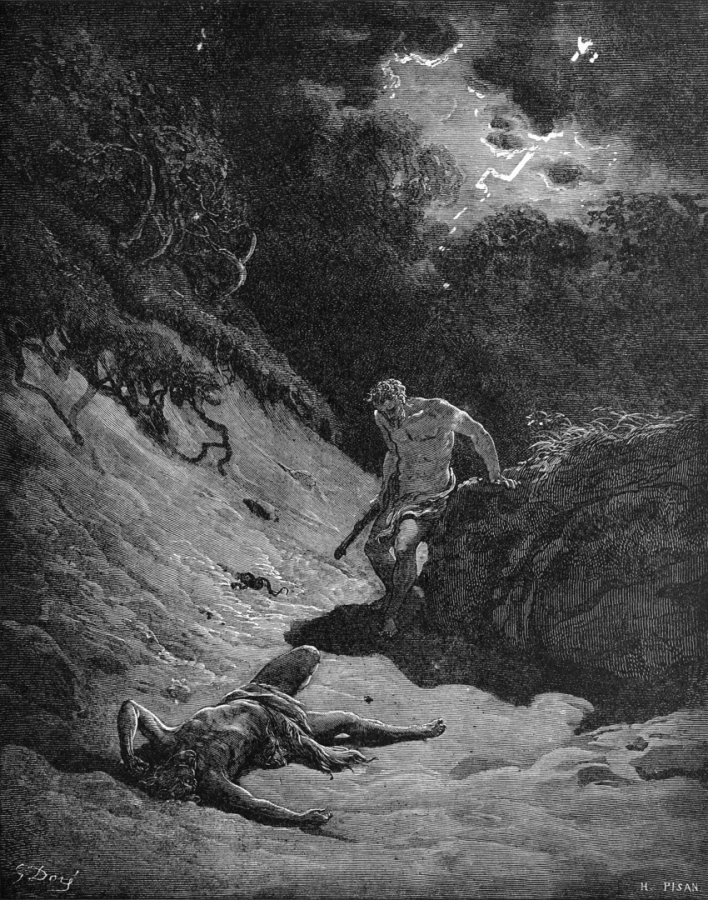
This is why symbols have more than one meaning. Jung also recognised that dreams have personal qualities that are intended for the individual alone. A conclusion can only be reached when all the symbols that appear in the dream are pieced together into a comprehensible story.
Jung’s belief that symbols and mythology embody human traits, his proposition has been labelled as “pseudoscientific theory”. Yet it is not without scientific reasoning that all humans share certain behavioural dispositions.
The problem Jung had in his day was that evolutionary psychology was not recognised as a credible theory. it was until the late 1990s that the research earned respect among academics – more than 30 years after his death.
Jungian psychologists, of which there is an increasing number, buy into the idea that archetypes define human nature and symbolism can be used to help patients bring unconscious content into conscious awareness. The difference between Jungians and critics is that the latter do not understand esoteric symbolism.
“Jung’s techniques are widely used in psychotherapy today; patients are encouraged to meditate upon a symbol, or to provide word associations with it in an attempt to unlock its meaning. Once this meaning becomes clear, the patient not only obtains new insights into his or her own mind, but usually finds that meaningful symbols begin to occur with greater and greater frequency, as if each unlocks a door into the unconscious through which other symbols are then allowed to emerge. ” ~ David Fontana, The Secret Language of Symbols
If your interpretation of symbolism is based on the exoteric meaning only, you will miss the point. As I explain in the Beginner’s Guide To Symbolism, exoteric interpretations are misleading.
This criticism points towards some of the past-times Jung adopted in his personal life. What critics rarely point out is that his supposed ‘psychosis’ was actually an experiment to explore the origins of unconscious content so he could heal himself.
Jung engaged in several experiments of note. The first was to build a miniature village using the pebbles and stones on the lakeshore near to his home in Zurich. Jung’s reasoning for this was to rediscover the vivid inner life he had as a child.
Another method of enquiry he pursued was to draw mandalas – symmetrical designs typically featuring a circle within a square. Mandalas have been used for thousands of years and Jung recognised they represented a symbol of wholeness – the psyche of a self-realised man. He encouraged his patients to draw mandalas for him to analyse.
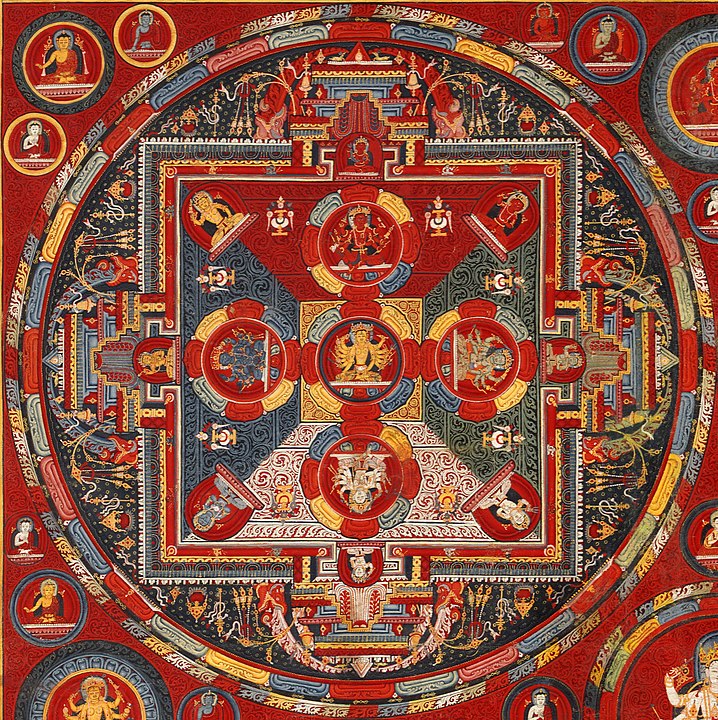
The building game and the drawing of mandalas helped Jung to develop a gift for ‘active imagination’; they released a stream of vivid dreams, visions and fantasies that helped him differentiate between the personal conscious and the mysterious second origin from which unconscious content surfaced.
Jung documented these experiences in his later work but because the images brought him into close contact with material that is considered ‘psychotic’ by mainstream psychology, his work has been used against him.
Counter argument:
I really don’t understand this criticism. It seems to me to be an attack on Jung just for being different. He was by all intents and purposes and extraordinary man. In my opinion, it is a disservice to criticise him for not being “ordinary”.
What is “ordinary” anyway?
It was through Jung’s work with schizophrenia that he recognised the link between the human psyche and the symbols that consistently crop up in ancient mythologies. Calling Jung’s theories as being outside “ordinary” reality is a short-sighted view offered by people that simply have a different approach to psychotherapy and life in general.
Or they don’t have an imagination.
I have a good understanding of symbolism and can clearly see how the unconscious communicates with us through symbolism; in dreams, analogies, through symbols etc. With this knowledge, I have cured my own mental health issues, helped my sister understand her dreams and integrate her animus together with many other people that have reached out to me.
There have also been numerous conversations with people that do not believe there is a connection between symbolism and the psyche. I am more than aware that, to the uninitiated, symbols and dreams do not make any sense. It is clear why Jung receives so much criticism from his peers.
There is, of course, an argument to say, ‘why doesn’t the unconscious just tell us what we need to know.’ It’s a fair point. Why the unconscious prompts us with mindboggling images is arguably a fact of life we will never be able to fathom.
However, analysts that are proficient in interpreting symbols have shown it is possible to help people overcome neuroticism.
Critics that have accused Jung of suffering from psychosis have probably never experienced anything paranormal or out of the ordinary. Otherwise, they have simply dismissed such experiences because they have no rational explanation for it.
Yet Jung differs here again. He actually developed a technique that enabled him to induce visions and hallucinations by allowing the conscious mind to flow back and forth between the unconscious and awareness. Self-inducing visions is not psychosis.
Anybody that has tried, and become adept at lucid dreaming, can probably relate to Jung’s ‘active imagination’ exercise. Likewise, anybody that can fall into a deep meditative state through meditation or yoga Nidra will know how it is possible to invite vivid images into your mind’s eye.

It is a known fact today that children become less imaginative after attending school. Studies reveal that a child’s innate creativity becomes nullified to the point they are less able to produce unique and unusual ideas. Other people can’t focus long enough to think deeply. The average attention span is around 9-seconds.
Jung arguably recognised that because most people lack imagination, the inspiration they have cannot be part of the personal unconscious. It must, therefore, be part of the collective unconscious.
But regardless of the origin of unconscious thought, Jung recognised the goal of life was to integrate unconscious content into the conscious mind. He proposed the ‘process of individuation’ was mastery of both the outer physical world, which is moulded by common belief systems within a cultural structure, and the inner world which he related to archetypes portrayed in world mythologies.
This suggestion had been considered radical at the time. Freud had also encountered criticism when he fathered the idea of the unconscious many years earlier.
Jung also believed the patriarchal system imposed into western culture separated westerners from exploring the unconscious. A divorce from our imaginative faculty does not enable us to recognise and integrate aspects of our nature that are absent from conscious reality.
It’s worth remembering that Jung’s conclusions were reached by years of working with patients suffering from schizophrenia and psychosis. The reason for their mental illness was because the conscious mind – shaped by society’s norms – was unable to associate with traits that constitute human nature.
An inability to invent unusual ideas also accounts for why a large proportion of the scientific community has been accused by their peers for basing their opinions on materialistic training.
“Get over it, and accept the inarguable conclusion. The universe is immaterial-mental and spiritual” ~ Richard Conn Henry, The Mental Universe (Professor of Physics and Astronomy at Johns Hopkins University
In my opinion, Jung did not suffer from personal psychosis, he had an imagination and understood how to bring the contents of his unconscious into conscious reasoning.
But Jung’s critics do make valid points in relation to some of his ideas. There is very little in the counter-arguments, to suggest the second source of consciousness is merely a deeper layer of the personal unconscious.
Other than memories stored in genes, the evidence in support of a collective unconscious cannot be scientifically tested so, of course, cannot be scientifically proven or disproven.
Regardless, Jung’s understanding of symbols and the psyche do have a place in psychotherapy. Moreover, we cannot rule out the possibility of a second source of consciousness that comes from outside the body. No matter where it comes from, consciousness does seem to try and guide us in the right direction.
When I tell people I decode symbolism and explain how the unconscious works, it is met with mixed reactions. Some people say “cool” whether they know about symbolism or not. Others are generally interested and want to explore the topic whilst others position it in the ‘mystical’ bracket and don’t believe a word.
My only response to this latter group is do not base an opinion on something you have never explored for yourself. If you don’t see how something works, you cannot understand that it does work. But clues do exist.
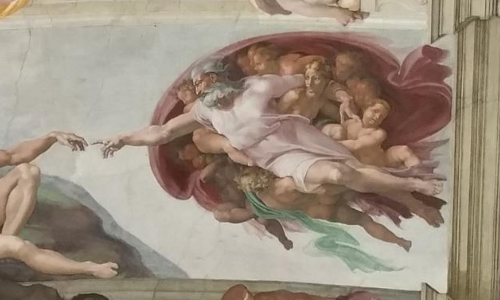
They used these observations to understand the human psyche. Moreover, they used nature as symbolism to explain human nature in story form. Mythologies are a work of genius.
People that don’t believe symbolism has any significant meaning take the common view that ancient cultures were “primitive” and thus could not have had such a profound understanding of the world or the human psyche.
Moreover, the dominance of behavioural science in modern thinking gives rise to the opinion that the physical world is the only true reality. It is also argued that psychological phenomena are hallucinations or psychosis.
As a result, behavioural psychology typically focuses on how the human body functions in response to external stimuli. They reject the existence of unconscious instincts and classify actions outside “ordinary reality” is a mental health issue.
As a matter of fact, I once had a conversation with a behavioural psychologist. My immediate response to her profession was “Oh, so you must know how the unconscious works.”
Her response was, “My patients are not ready to work with the subconscious yet.”
As you can imagine, I was taken aback by this comment. It is widely regarded that between 90-95% of our actions (behaviours) come from the subconscious. Surely by observing these behaviours, analysts would be able to identify patterns and trace the behaviour back to a root cause.
In behavioural psychology, apparently not. The irony is staggering.
Let me give you an example:
Recently, on two separate occasions, Saturday and Sunday in the same weekend, I encountered a black cat on the street. Both times, the cat approached me, let me stroke it behind the ear, then weaved in and out of my legs. They were not the same cat because I was in different neighbourhoods miles apart.
In my experience, this is very unusual behaviour for cats when they first meet a stranger. They normally stare for a while then scurry under a car.
If you look up the symbolic meaning of cats on the internet you will find they represent “communication”, “magic”, “death and rebirth”, “healing”, “independence”, “patience”, “curiosity” and a few other things which don’t really mean anything. These are the misleading exoteric meanings I mentioned earlier and sure enough, most of the explanations offered on these websites miss the mark.
The esoteric meaning is a signal to slow down, rest, still your mind and communicate with your unconscious. Cats are spiritual animals.
The synchronicity of seeing cats for me was a reminder to reconnect with my inner-world. When they appeared, I had spent six hectic weeks moving country, moving apartments, catching up with friends, organising visas, working a full schedule and celebrating Liverpool FC winning the league (just thought I’d sneak that in. It’s been 30 years!)
As a result of all the distractions, I had neglected my meditation, my diet and forgot I am not 25 years old anymore. Moreover, I was not listening to the Feminine Principle which asks you to take care of yourself, love, nurture and be creative. Having neglected the Feminine, I was feeling overwhelmed, exhausted and chaotic.
The appearance of the cat was a reminder to be still (patience), connect with my unconscious (communication, independence, curiosity) and recharge my batteries (healing, death and rebirth (of energy), magic). Given the cats were black, my unconscious was warning me that the devouring mother (symbolised by a witch in mythology) would be on my case if I continued to neglect my body and mind.
At the time, I didn’t pay much attention to the colour of the cats. However, when I started feeling frustrated, moody and irritable a few days later, I realised the devouring mother was entering my realm of consciousness. So I took the foot of the gas, re-organised my lifestyle and restored balance.
First of all, this example illustrates why you need to know the esoteric meaning of symbols and not simply accept the exoteric meaning you find on multiple websites. Cats are not a “Go-Go signal” or an incentive to take risks just because they are said to have nine lives!
Secondly, it illustrates that you need to be consciously alert in order to notice synchronicity of numbers and symbol or real-life experiences that could be symbolic. When something unusual happens more than once in quick succession, take notice.
Thirdly, it doesn’t matter too much if you don’t notice, or initially understand, what symbols and numbers are trying to tell you immediately. If you are aware your unconscious is trying to tell you something, you will reach the right conclusion eventually.
Symbols are a means for the unconscious to communicate to the conscious mind in a way that enables you to understand your inner world. What happens in your inner world is projected into the outer world. This is the Law of Correspondence – a law of sacred science, not modern science.
Having used symbols for my own personal development, together with helping many other people as well, it is my belief that interpreting the esoteric meaning of symbols can help guide you towards an understanding of your inner world – the unconscious content trying to get out.
In addition to Freud and Jung, evidence of this has been put forward by several respected psychologists including Edward Erdinger, Louise-Marie von Franz and Erich Neumann to name a few.
“Some of the symbols in such dreams derive from what Dr. Jung has called “the collective unconscious” that is, the part of the psyche that retains and transmits the common psychological inheritance of mankind. These symbols are so ancient and unfamiliar to modern man that he cannot directly understand or assimilate them.” ~ Joseph L. Henderson, Man And His Symbols
Just to remind you, Jung said archetypes reside in the collective unconscious. This aspect of the unconscious then projects on to ego-conscious.
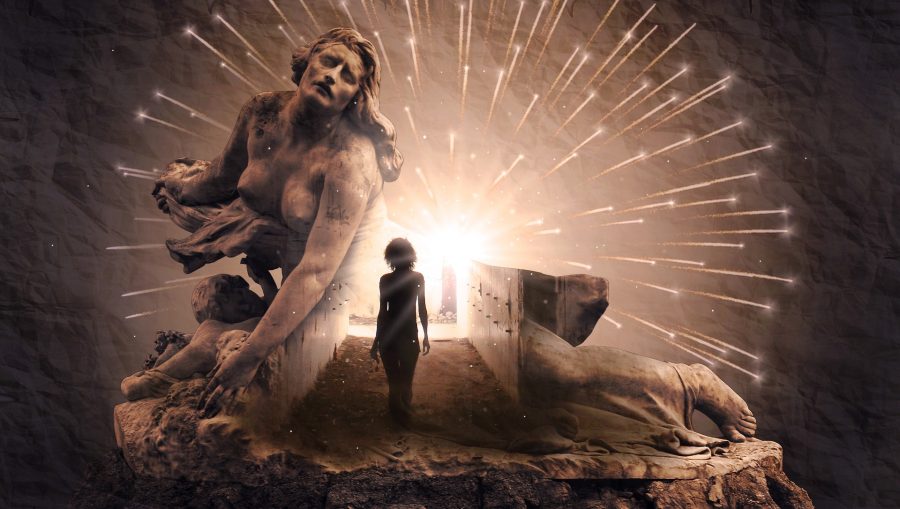
Understanding the meaning of symbols reveals aspects of your personal nature that have been obscured by subconscious programs. Personal content has been repressed or suppressed is information absorbed from the material world by the sense organs.
This information includes what you have been told by your parents, teachers, religious leaders, politicians, the media and have subsequently become societies norms.
Much of this information is low-quality information and is ultimately responsible for limiting beliefs, negative attitudes, character weaknesses, low self-esteem, a lack of self-love and many other neurotic behaviours that plague society.
It’s worth noting that subconscious programs with poor information create a false reality, a perception of the world you believe is material reality.
Some scientists say reality is an illusion. Some say psychological phenomenon is an illusion. Opinions will always be split in the current paradigm and people will be biased towards a certain opinion based on the information already stored in their personal consciousness.
This is why Jung’s theory of the collective unconscious draws so much criticism. The majority of physicists probably don’t agree there is a higher consciousness that exists outside the body. When I told my dad atomic particles communicate with one another (string theory) his response was “Bollocks!” His opinion was based on a fifty-year-old belief about atoms he learned at University.
You must decide the puzzle of the unconscious for yourself. However, let’s give the matter closer inspection. If the personal unconscious is responsible for instinctual behaviour and intuitive feelings, how do you explain weird experiences that are clearly intuitive, but cannot be attributed to content in the personal unconscious?
These moments cannot be explained by genetic inheritance either.
“Our pursuit of understanding spiritual experiences is now a part of what it means to be human.” ~ Kevin Nelson, MD – The Spiritual Doorway in the Brain (Neurologist)
It seems apparent to me that thoughts surfacing in my mind appear to come from a second source that is not from personal experience. Some of them cannot even be information stored in my genes. You have probably had weird experiences you cannot explain as well. How many times have you had a thought come to mind but have no idea how or why you would think that?
You may remember I mentioned that quantum particles in atoms hold multiple megabytes of information and that several independent scientific experiments reveal that quantum particles can communicate with each other over vast distances.
It is also widely accepted that we receive “messages from the Universe”. Even if you believe this is only a saying, I suspect you have had weird experiences that you cannot explain with any rational thought.
On the other hand, some of the weird experiences I have had can only be explained by the mysterious second source. Moreover, these experiences are why I believe it’s important to understand esoteric symbolism if you want to understand the True Nature of consciousness.
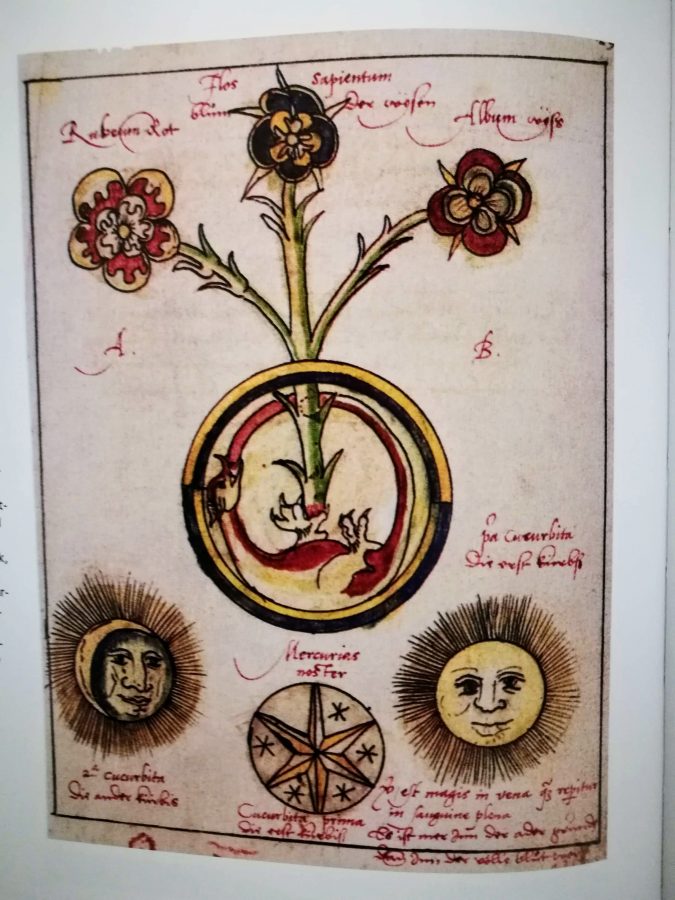
For me, this doesn’t make sense. Sometimes you have a feeling that something is not right or is right before it happens. Sometimes, these feelings arise to new experiences.
Intuition can also feel vague, but as thoughts begin to take shape, the ego judges the content. This is not always the best thing to do. It is in these moments when the ego gives you his false rationale and you can lose sight of the pure wisdom stirring within. You then go against your intuition only to learn later that your intuition was right.
You may also have other intuitive experiences that come from the higher conscious and prompt you into action. They are typically weird experiences you can’t explain. People will typically pass these experiences off as a supernatural experience such as a “message from the Universe” or the “spirits/angels guided me.”
It also communicates to you in those ah-ha moments and when answers to things you have been thinking about miraculously appear from “out of the blue” or you instinctively know something is right.
For example, in a flash of inspiration, you suddenly understand everything, but then the idea fades and the ego-mind is confused about the information that flashed into your mind. It can take hours, days or even months for that moment of understanding to be realised in the conscious mind.
Is that a learned behaviour? Is it content stored in the personal consciousness?
Sometimes yes, but not every time.
How many times have you had an experience that cannot be a learned behaviour that you are certain cannot have originated from the personal unconscious/subconscious mind?
Jung’s archetypes explain why this might happen. Your unconscious is not only trying to help you thrive, they actually provide information in the moment you need it. The unconscious is pure wisdom.
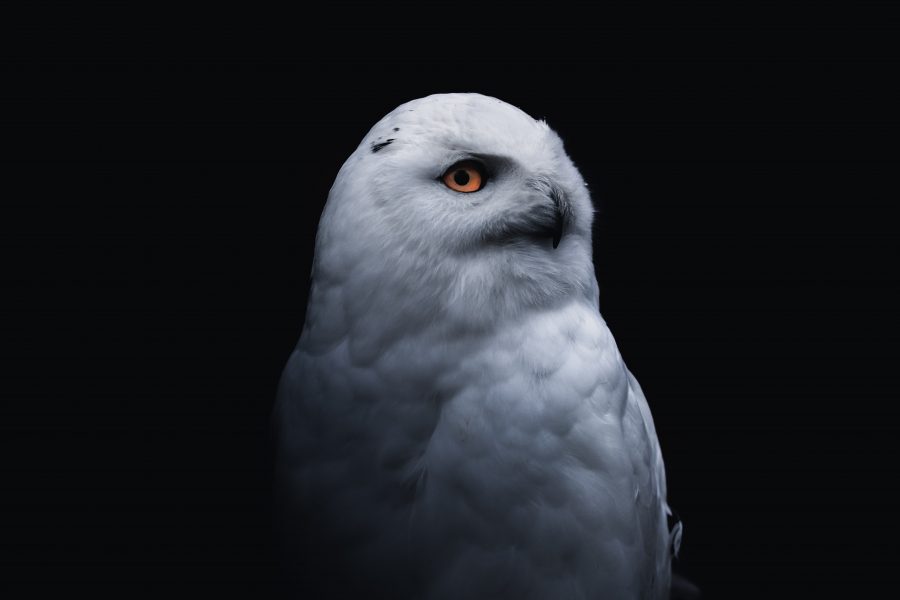
This is why it’s important to know where your thoughts are originating from; personal unconscious or the collective unconscious.
I’ll give you a personal example of a time when I connected to the higher self (although at the time I did not realise that is what was happening).
At school, I took a class called European Studies. It was an alternative option to Geography but solely on Europe. One day, the teacher, Miss Colliwell, gave us a quiz for a bit of fun at the end of the school year. She would describe specific features of a city and the pupils had to identify the place.
I remember the first city she described was Paris. The second city was Moscow.
When Miss Colliwell saw what the third city was, she said: “Oh this one is a little more difficult.”
A thought immediately popped into my head. “Rio de Janeiro.”
I’ve no idea why Rio de Janeiro would surface in my 14-year-old mind. We were studying Europe. After two descriptions had been read, I knew it was “Rio de Janeiro” so spoke up. The look on Miss Colliwell’s face was one of bewilderment.
Some people would chalk this down as a lucky guess but the thought came to me before any clues had been read. Also, this kind of thing happened to me quite often as a teenager. The chances of me guessing the right answer are, I imagine, pretty high.
Moreover, if I was going to consciously guess a city beforehand, it would have been a city in Europe – given the class was European Studies.
The experience cannot be simply passed off as a learned behaviour either. How would I learn that? So the information did not come from my personal unconscious. Evidently, the thought came from the unconscious but it was not a repressed emotion resurfacing.
The only rational explanation I have is that in that moment, I connected with the Cosmic Intelligence. So imagine if it were possible to tap into the Unconscious and retrieve answers you need to know in an instant all the time.
It is when you expand conscious awareness.
People can criticise Jung and every other original thinker all they like, but in doing so, they only prove they have no imagination, are bound by programmed information and have a closed mind.
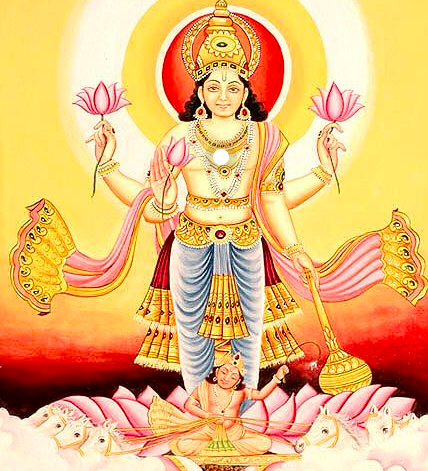
Aryaman, or Aryama, is said the be your best friend and is invoked with Mitra and Varuna, which I established in a previous article represent the conscious aspect of the ego and shadow self. In accordance with Sigmund Freud’s model of personality, Aryaman is the voice of reason – although sometimes he doesn’t say much. He is very much a live-and-let-live type of guy.
However, he is Truth – the voice of expressive knowledge that will deliver joy and power when merited. The Vedas refer to him as a “guard of the Sacred Laws”. The cosmic laws of consciousness.
In true alchemical fashion, Aryaman is associated with chivalry, honour and nobility that govern the rules of society. He is the disciplinarian that orders us to do the right thing – to carry out your dharma in the way your consciousness is ordained.
The Hindu god could be said to be the power and determination that enables us to transcend above the whims of the ego, the immatured mind that is all about wanting and desire. And he is. But Aryman also sits on the fence and allows us to make the same mistakes then sits back to watch the Aswins karma twins kick your ass.
There is an ancient shamanic expression about two wolves that reside within us. One of the wolves is a mellow, friendly wolf, and the other is an angry, pedantic wolf. The wolves fight a lot. The wolf that wins is the one you feed the most. And that is the wolf that is reflected in your nature.

However, the Super-ego resides in the personal unconscious which is often programmed with limiting beliefs and false Truths you have been told by parents, teachers, the media, and religious and political leaders. There are times when you have to feed the shadow self. As the psychoanalyst, Carl Jung pointed out, if you are not aware of the dark side of your nature, it can be dangerous for the psyche.
In The Republic, Plato used the allegory of the shadow on the cave wall to reflect his knowledge of the unseen darkness that lies within us. After a lengthy dialogue, Socrates concludes:
“The process, I said, is not the turning over of an oyster-shell, but the turning round of a soul passing from a day which is little better than night to the true day of being, that is, the ascent from below, which we affirm to be true philosophy?”
In Hindu mythology, Aryaman is represented as a dutiful god that controls time and judges the whims of Mitra (the dawning of self-knowledge) and Varuna (the egoic mind) impartially. The gods are the opposing wolves of the personal unconscious that “ascend from below.”
The ancients were verily aware of our dual personalities and understood the need for frivolity as well as the need to restrain ourselves and take everything in moderation to keep our soul in sync with our life’s purpose. Like everything in nature, we need balance to thrive. Aryaman is that balance so when he does speak, listen to him.
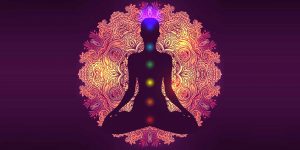
The chakra system is seven energy centres that flow up from the base of the spine to the crown of the head. These energy points facilitate certain areas of the body and are responsible for health and healing.
Furthermore, the health of the chakras is determined by your thoughts, emotions and actions. They are essentially a reflection of how you feel about yourself and the world around you. Chakras typically close and fall out of sync because of negative emotions and personality traits.
In the West, closed chakras typically arise because of the way society is designed. There is a widespread lack of communication about the power of these energy centres, even to the point that people – including physicians – don’t believe they really exist.
I will explain a little more about why energy centres and holistic healing practices, in general, are ignored in the West in this article. If you would prefer to focus solely on the meditation, skip to the abridged meditation here.
Anybody that meditates and knows how to balance and open their chakras will – and can – tell you differently. The seven principal energy centres are typically called ‘pressure points‘ in Western medicine.
“As with chiropractic, the history of homeopathy is intermingled with the history of the AMA (American Medical Association). In the 1840s, homeopathy became the most dominant form of alternative care in the united States. It is no coincidence that the 1840s also saw the early beginnings of the AMA. The AMA staunchly, and successfully, opposed the practice of homeopathy and enhanced the credibility of biomedicine. Then, in 1910, the Carnegies Foundation, in cooperation with the AMA, issued the Flexner. Report, which nearly destroyed homeopathy in the United States. By the mid 1930s, the last homeopathic college, the Hahnemann Medical College of Philadelphia, ceased teaching homeopathy (Coulter, 1982” ~ Alternative Therapies: Expanding Options in Health Care, Rena J. Gordon, PhD, Barbara Cable Nienstedt DPA and Wilbert M. Gesler, PhD (1998).
Gradually, through simple 10-minute practices like this one, people are learning how meditation can help you to open and balance your chakras and bring more harmony into your life.
When the chakras are open and balanced, you attract happiness, fulfilment and harmony into your life. When the entire system is aligned you physically feel more positive and radiant.
The chakras are a reflection of how we see and feel about ourselves. But thoughts and emotions stem from the subconscious mind which tends to take control through habitual programs.
It is only when you are aware of how the subconscious mind works that you can train your conscious mind to send the right messages to the unconscious mind. Learning this meditation to open your chakras is only one way of communicating with your subconscious.
The unconscious mind stores and retrieves information like the hard drive on your computer. It processes around 11 million bits of raw data per second. This comes from sources such as media, advertising, TV, radio, conversation and every other experience you have from one day to the next.
This is why so many of us are angry, antagonistic, depressed, anxious, lacking hope and crippled by fear.
It is not a coincidence that medical centres are receiving record numbers of patients suffering from anxiety and depression including students.
In comparison to the 400 billion bits of data processed by the subconscious per second, your conscious mind only processes about 40 bits of information per second.
This information is the sum total of your experience and understanding of the world, and ultimately, who and what you think you are. It is from these 40 bits that perceptions create your understanding of reality and your ego develops.
The ego is the self-regulating mediator between the subconscious and the outer world. It is the seat of your objective identity and prompts you how to act in certain (programmed situations).
The ego and its habitual programs can be very useful.
However, the ego is not always your friend. It typically bows to the whims of your habitual subconscious which in turn has often been deceived by external influences; (parents, teachers, media, political and religious leaders etc).
Case in point: Look where Carnegie, Rockefeller and the AMA have gotten us to! –
“One person dies every 37 seconds in the United States from cardiovascular disease.” ~ Centers for Disease Control and Prevention
This 10-minute meditation to open your chakras and bring them into balance will help you lower stress levels. Lower levels of stress can help to reduce the risk of heart disease.
You can achieve power over your conscious mind by meditating on your chakra system and bringing the energies in line with positive emotional thoughts.
With a little practice, you will eventually develop the qualities of character and emotion you desire and these energies will resonate throughout your chakra system.
And then you will find you have more control over your thoughts, emotions and actions to create the world you want to live in, rather than this matrix of mayhem designed by people we call “Authority”.
A broken social structure = a broken chakra system.
You can make a start to preparing the social structure by fixing yourself first.
You may not be able to change the thinking of corrupt oligarchs but you can change the way you think about yourself and everybody else that lives in your world.
And hopefully one day, enough people will be awakened and healthy enough to convince world decision-makers in medical institutions to stop taking advice from people with self-interested policies (step aside Carnegie, Rockefeller and Gates!)
This 10-minute meditation exercise will take you through the entire body chakra system, explaining what each chakra represents and suggesting a mantra you can use to re-program your subconscious mind.
I typically start with my root chakra and work my way up to the crown chakra, but the path you take does not have to be in sequence. You may want to start with the crown and work your way down or pick energy points at random.
You can even use the mantras in this chakra meditation to focus on a particular energy point you feel you need to strengthen. If you want to concentrate on a specific emotion or character flaw you would like to purify, focus on that one point for 10 minutes.
The root chakra is located at the base of the spine and is related to stability; how secure you feel in yourself and around others. When open and balanced it eliminates fear and you feel grounded and confident.
To open and balance the root chakra, bring your attention to the area around your groin and imagine a red light glowing around your genitals up into the lower part of your stomach.
During meditation on the root chakra, concentrate your focus on the bright, red, glowing ball. Repeat this mantra:
I am the master of my mind and have nothing to fear.
Located a few inches under the belly button, the sacral chakra is the centre of self-love and is the colour of orange. Opening the chakra will make you feel emotionally balanced and optimistic.
During meditation on the sacral chakra, concentrate your focus between the rib cages, imagine a bright, orange orb and repeat this mantra:
I love myself, the world and everything in it.
The solar plexus chakra is located in between the lower rib cages and dominates willpower and self-direction. It is from here that you summon the strength and the courage to overcome obstacles.
As its name suggests, the solar plexus is yellow and like the sun has immense energy to burn away any fear and negative thoughts that prevent you from achieving what you most desire.

When the orange sacral chakra and the yellow solar plexus work “in tandem” they actually work in your “tanden”, the point the ancients say “is the centre of creation.”
During meditation, imagine a fiery, yellow sphere in the centre of your ribs and repeat this mantra:
I am confident in everything that I do and will overcome all challenges in my path.
The heart chakra is green and governs love, compassion and generosity towards others. It is the most important and highest chakra of the four lower (physical) chakras.
Located at the centre of the body’s energy field, the heart chakra connects the lower chakras to the higher chakras. You could say it’s HQ, the decision-maker that bridges the physical base consciousness with the forgotten higher consciousness.
It is perhaps the hardest chakra to open, as breaking down the barriers of your heart depends on how much you have been hurt in the past. You must forgive whoever has caused your suffering and accept that whatever happened was a lesson from the higher self.
When meditating on the heart chakra, focus on the centre of the chest and imagine a bright, green light emanating love, compassion and understanding for everything. Repeat this mantra:
I am love and have compassion for everything. I accept myself for who I am, and accept that other people are different.
The throat chakra governs your honesty and ability to express yourself. It gives you the power and the strength to speak to anyone and be comfortable in their presence.
However, this gift is also fuelled by the three lower chakras. You will learn more about your throat chakra in situations where you tell little white lies and half-truths to impress people.
This kind of behaviour is because you feel out of your depth and is a sign of overactive throat chakra. In reality, you have self-doubt and possibly a lack of self-worth.
An open and balanced throat chakra will make you feel comfortable speaking the truth about yourself or any subject to anybody. You speak eloquently and confidently without hesitation.
When performing this meditation to open your chakras, focus your attention on the throat and imagine a glowing blue ball giving you the inspiration to speak smoothly and freely.
Repeat this mantra:
I am confident in my words and opinions and can speak freely without hesitation
For many practitioners of self-realisation, the third-eye chakra is one that perhaps receives the most attention. It is the third eye chakra that gives us an increased awareness of intuition and telepathy.
The latest theory by online sources is that the third-eye chakra is located in the thalamus at the centre of your head, and is believed to be the pineal gland, although this is unproven by science.
If you squeeze the bridge of your nose where it meets your forehead, you will feel a light pulse of energy. That is your third-eye chakra. It will open your mind to new worlds, new perceptions and new opportunities.
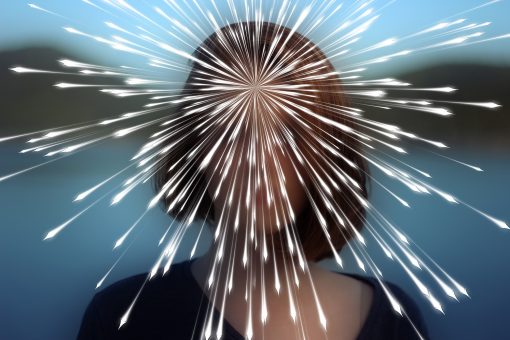
Through your third eye, you will have visions that reflect what you are facing in your life right now. Like dreams, they are profoundly symbolic and difficult to understand. Reading myths will help. I believe the sixth chakra is our mind’s eye.
To meditate on the third-eye chakra, imagine a blue orb in the centre of your forehead. The best way to open the third eye is through vibration. Repeat the mantra:
Thoh (pronounced like toe in English). Let the sound vibrate.
Located at the top of your head, the crown chakra is believed to be the antenna that connects our vibrational frequencies with our higher self and the morphic resonance field, also known as the Akashic records or the collective unconscious.
Regardless of how you look at the crown chakra, it has a mystical or spiritual connection that cannot be rationally explained by modern science; only religious dogma.
Essentially, the Sahasrara connects us with the vibrational energy of the universe and is the seat of intuitive knowledge and wisdom. When opened and balanced, we have a strong connection to our higher self and when closed suffer from disorder and chaos.
Meditation of any kind is beneficial to the health of the crown chakra. Simply sitting still in silence helps you connect with your higher self. Therefore, there is no mantra. Just empty your mind and be in the present.
Performing this meditation to open your chakras for 10 minutes every day can have noticeable changes. If this is your initiation to mediation and balancing chakras, we trust you recognise the benefits and want to learn more.
If you suffer from anxiety and depression, I know how yo feel. I struggled with social anxiety for at least 20 years, maybe more. In my search for a cure, I visited several psychologists with zero results. The anxiety exercises I was shown offered very little in the way of managing anxiety and did absolutely nothing for curing them.
Anti-depressant pills were even worse. They made my anxiety worse – to such an extent I felt my skin crawling. The pills went in the bin after just days.
After several years of working with trained psychologists, I gave up. I was not convinced then, and I am not convinced now that conventional treatments for anxiety and depression offer a solution. Even medically trained professionals are questioning the value of pharmaceuticals.
There’s a reason for that.
“It is very difficult to make economically viable models for antibiotics. With heart medication or anti-depressants, a lot of people take them for a long time so you can make money back. An antibiotic that works is unlikely to be used for more than a couple of weeks.” ~ Colin McKay, from the European Federation of the Pharmaceutical Industries and Associations
According to the World Health Organisation (WHO), around 260 million people suffer from anxiety disorders. The precise causes for anxiety are unknown, although mental health studies attribute them to genetics, environment, and personal experience.
What experts do know is that anxiety is largely attributed to psychological disorders. How you think has a knock-on effect with your biological system.
What’s more, psychological disorders can easily be avoided because the mind creates a perception of reality that is not always true. But what the mind can create, the mind can cure.

The ancient Greeks used a similar concept Hippocrates called ponos. The ‘Father of Modern Medicine’ discovered that prolonged exposure to stress is a significant burden on the body and causes an imbalance that leads to illness.
Ponos would later be written into Greek mythology as the God of hard labour which is literally associated with the toil of work. However, when the meaning is applied symbolically, it reveals the strain the body suffers from the release of neurotransmitters.
Neurotransmitters are chemicals that are naturally released in the brain and the cause of emotions. They also carry messages from the brain, through the central nervous system and peripherals nervous systems so the body functions as it is supposed to.
One of the functions performed by the brain is to release neuro-chemicals in relation to a thought. When you have a thought, or experience you are affair off, the subconscious mind tries to protect you from perceived threats by releasing adrenaline.
Neurotransmitters are essentially nature’s way of self-preservation. The subconscious is merely protecting you from physical and emotional stress. Once the perceived threat has gone, your bodily functions return to normal and work begins on cleaning out toxic chemicals so that infected parts can grow and heal.
However, because modern lifestyles cause the brain to trigger stress hormones on a regular basis, the body struggles to regulate toxic chemicals. The result is a mental and physical illness, one of which manifests of anxiety.
The root cause of anxiety will be different for everyone, but in general, it is a psychological disorder that originates from a false perception manufactured by the mind.
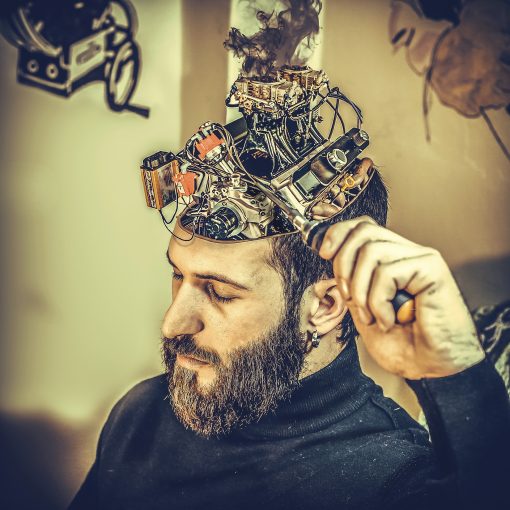
Perceived threats cause the mind to close down in order to protect you emotionally. If this happens on a regular basis, you can develop psychological patterns of negative thinking.
I can speak from experience. When I was a teenager I’ve suffered from stress-induced anxiety. My belief was that nobody liked me because I used to get picked on a lot. Most days I felt outcast and alone.
In reality, I had a lot of friends. However, I was small and had alternative views. Because of this I lacked confidence and was often afraid to speak for fear of being ridiculed.
This caused me to feel anxious. Yet the problem was not that people did not like me, I was just an easy target for people to pick fun out of me. But the reason for that is because in my mind, I didn’t think people liked me. Subsequently I developed an attitude that was a barrier to protect my feelings.
The idea that nobody liked me was a self-fulfilling prophecy and by the time I left school I had lost friends and rather than being picked on was bullied. In reality, it was because I didn’t like myself. And that’s a whole other story.
There were times when I was walking to school that my stomach would churn and my legs felt weak. At the time, I didn’t realise anxiety festering throughout my body.
When I was 31, I had a full-blown anxiety attack. My entire body froze, I was vomiting, and I couldn’t breathe. At one point, I couldn’t breaths and seriously thought I was going to die of asphyxiation.
To overcome my anxiety disorder, I visited several psychologists. They gave me pills that made me feel worse. They asked about my family but didn’t explore feelings about my past or help me find a root to the problem. The root of the problem was never even mentioned.
For an hour or two after these sessions, I felt better. But as I lay in bed at night, that familiar heavy feeling lingered in my stomach. On a bed night, I would lay in bed shivering.
I decided conventional medicine was a waste of time of money. So I turned to meditation. At first, that made the anxiety worse, because I couldn’t relax. And I didn’t know how to. Furthermore, I was not meditating properly – I was using a handbook method which, practically, is useless.
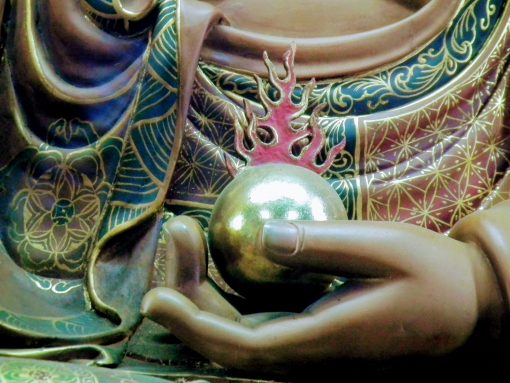
Once I mastered the art of meditation over several years, I developed mechanisms that enabled me to relax my mind, and subsequently my body. I then developed a technique that enabled me to determine the root cause of my anxiety. it turned out to be the same technique the alchemists have been showing us all along – albeit their teaching are disguised by esoteric symbolism.
Decoding the hidden meanings of symbolism, essentially helped me to perfect healing techniques you can use to cure anxiety and other illnesses. Both my sister, Michelle and I have removed the emotional wounds that were responsible for limiting believes in our subconscious programming that caused anxiety and debilitating mental disorders including drug addiction, bulimia and body dysmorphia.
The pinnacle of my anxiety disorder occurred in 2006 when my entire body froze and I vomited violently. I almost choked to death on my own vomit. In the subsequent three years, it became apparent psychology had not accounted for the mind’s role in causing anxiety. It was certainly never explored by the practitioners I visited.
Today, brain chemistry is being studied much closer with the use of fMRI technology. Researchers now think that the areas of your brain that control fear responses may be involved.
This diagnosis makes perfect sense. Studies have shown that anxiety is generally linked to experiences in life that trigger the Fight-Flight, or Freeze mechanism. Common problems include:
Life experiences such as these cause a lack of self-esteem. They can make a person easily flustered and feel inhibited. As a result, you become timid and the anxiety gets even worse.
Anxiety can often start in childhood and become exacerbated by the pressures of being an adult. However, that is not always the case. Anxiety in adults can also develop due to:
Regardless of the cause of anxiety, the disorder should be addressed before it becomes debilitating to your life. Some people don’t even realise they have anxiety until it manifests as an attack.
When you meditate, or just sit still and observe your feelings, you can self-diagnose whether you have anxiety or not. If you do, try these five exercises to help.
Jacobsen’s muscle relaxation therapy is a great exercise to perform just before you go to sleep. It helps you loosen the tension built up during the day and helps you get a good night’s sleep – which also helps combat anxiety.
I’ve dealt with the mechanics of Jacobson’s muscle relaxation therapy in a previous article, so won’t go over it again here.
Also, for more tips about how to sleep with anxiety, check out the advice from the guys at Tuck. They are experts in this field.
(Disclaimer: I have no association with Tuck, nor am I involved in an affiliate program with the company. I just appreciate the work they do).
Anxiety is a symptom of stress and can be aggravated by chemicals as much as it can by physical, mental or emotional influences. Therefore, anxiety can be improved or worsened by what you eat.
Scientists have discovered that a healthy diet rich in probiotics help to alleviate anxiety. When you consider that emotions arise from the sacral chakra in the pit of the stomach, this makes sense.

A study performed on psychology students that were prone to high anxiety in the College of William and Mary experienced fewer symptoms of social tension after keeping to a diet of fermented foods.
We already know that probiotics alleviate gastrointestinal symptoms, and that anxiety is accompanied by turbulence in the stomach. It was discovered that the intervention of probiotics helped to ease neuroticism because the body was able to respond to stress better.
If you do suffer from stress and anxiety, avoid caffeine, alcohol, dairy, sodas and fried/fast foods.
Anxiety is predominantly caused by the mind. The stories you create in your head are usually false perceptions. And because society is designed to make you have negative thoughts that act as self-deprecating values, your anxiety gets worse as you get older.
Taking charge of your mind is the key to curing anxiety. It is therefore prudent to be mindful of your thoughts. When you have a negative thought, notice it, and try to alter your way of thinking by looking for the positive spin on the situation.
And there is always a positive spin.
Whilst the first two anxiety exercises in this list help you to manage your condition, the cure starts with understanding your mind.
Worry, anger, hate, stress and all the other negative thoughts that emerge from fear-based emotions are damaging to your mental and physical health.
You can use mindfulness techniques to understand where these feelings are coming from, and once you know the source, you have the power to reprogram your mind.
This is what Master Mind Content teaches you how to do in our 9-Step Anxiety & Depression treatment and also our 11-Step Self-Development program.
It seems that every alternative therapist suggests using positive affirmations to help change mental programs and encourage positive thoughts and emotions.
The reason for this is that affirmations work – but only if they are performed correctly. Standing in front of a mirror and repeating mantras over and over is not an effective exercise for curing anxiety or depression. What is does do is enable the mind to recall positive actions when you need them.
Neuroscientists have a saying: “What is fired is wired.” They have this mantra becomes when we have a thought, it fires a neurone in the brain which then carries a message (via neurotransmitters) to other parts of the body.
When a thought, idea, belief system, or action is fired often enough it becomes wired – in other words, it fixes itself as part of your permanent make-up.
Thoughts, trigger emotions and emotions prompt actions. The energies this triumvirate of conditions generate becomes your personality, characteristics and gait.
Therefore, when attempting to release yourself from negative thinking patterns and install positive programs into your subconscious, you have to evoke the appropriate emotion you want to associate with a thought.
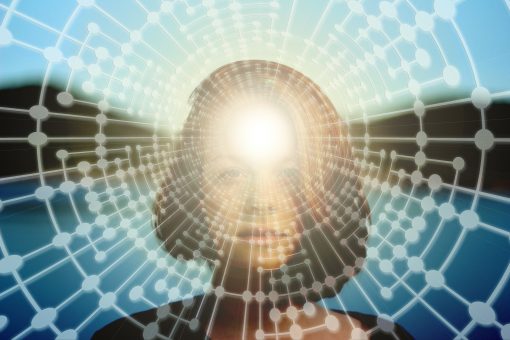
People that suffer from anxiety have thoughts and emotions that promote neurochemicals that cause social tension. Use self-talk to switch negative thoughts into positive outlooks, and use your imagination to invoke emotions you want to relate to specific thoughts.
You can do all this by learning how to use positive affirmation in the correct way. With practice, you will master your mind and learn to take control of your emotions. Then you can kiss goodbye to feeling anxious about anything.
Theories about the unconscious mind vary widely in the field of psychology. For me, the theories of Carl Jung and Jean Piaget resonate with me the most – together with Sigmund Freud’s topographical model of the Mind, of course.
It is understood that the subconscious mind also performs many functionalities. One of the most important, that often gets overlooked, is that the subconscious attempts to communicate with you through emotions, symbols and physical prompts such as aches and pains.
When you observe your unconscious and understand what these prompts are, you are better placed to make decisions that improve your life. And good decision making is required for all aspects of your life.
Master Mind Content has extensive knowledge and a library of content that helps you read and understand your subconscious through sacred symbolism.
We are also working to better understand metaphysical pains which you can use to help release blocked energies that are typically caused by thoughts and actions that hold you back. Your unconscious wants you to stride forward.
If you suffer from anxiety, depression or other issues that you feel limits your enjoyment of life, contact Master Mind Content and learn how powerful your mind really is.
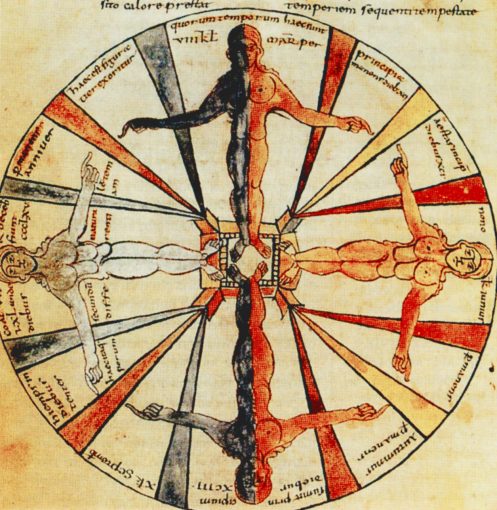
The four elements have a significant influence on our conscious mind. Ultimately what you manifest in the physical world can be attributed to a characteristic of earth, air, fire and water. Symbolically the four elements represent patterns of energy that transform life and by understanding their influences can be used as a tool for self-development.
Once you learn how to work with the elements, you will have more power over your emotions, thoughts and actions – the magical triangle of manifestation. You will be able to determine how your mastery of each element is progressing by the way you react to specific events in your life.
The ancient Greeks believed the four elements created all matter. Even today, they form the cornerstone of modern philosophy, science and medicine.
The four elements are therefore used in ritual magic which draws inspiration from ancient traditions. However, they can be put to better use as a self-development tool.
By mastering the four elements to transform your strengths into weaknesses, your will manifest the things you want from life and will be at peace with yourself and everyone around you.
Control of your emotions comes from within. When you learn to obey the laws of nature from the inside, the astral plane, they manifest on the outside, the physical plane.
The four elements manifest on the physical plane and influence you in the following ways:
The nature of the four elements impact on your emotions in ways that correspond to their physical nature:
Fire = anger/passion
Water = sadness/joy
Air = fear/love
Earth = depression/vitality
During the course of your life, you will face ordeals, all of which are tests that need to be overcome by the Self gaining control over ego. Each time you encounter an ordeal, repressed emotions sink deeper into the subconscious and manifest physically as thoughts and emotions which often compel actions.
To overcome your ordeals successfully, you need to be aware of your ego and let go of any negative emotion. If you allow your emotions to get the better of you, ordeals in the future become harder to overcome.
We need air to breathe. Without it, we would not exist. It is the element that most influences your mind and has the quality of movement, something that is not fixed and solid, but flexible and constantly moving. Air is the balance between fire and water and enables the mind to liberate the bonds of earth.
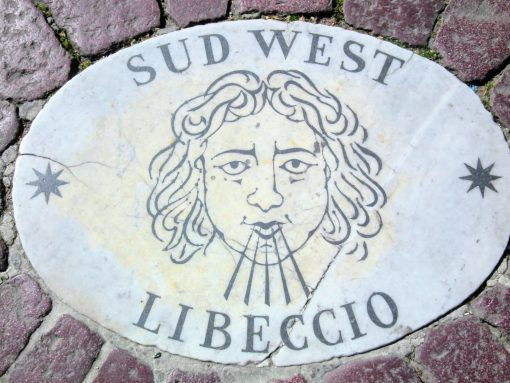
For example, if you do not want to go out one evening, but think your friend will be upset so you go out of guilt, you will probably not have a good time and wish you had not gone. But would your friend really be upset with you, or is that a perception you created from your own thoughts?
Air obstacles typically challenge your perception and by thinking negatively makes you feel insecure, anti-social and fickle. To overcome these concerns, you need to balance air with the element of fire to be self-respecting and courageous enough to say no and risk disappointing your friend.
The best way to work with air is through breathing. This is achieved with maximum potential through meditation or some form of physical exercise.
Should you need to invoke the power of air to develop a characteristic or emotion, use yogic breathing techniques. Take in deep breaths and breathe all the way out, squeezing the air out of your lungs. This is known as diaphragm breathing.
Whilst meditating, it is to your advantage if you are able to visualise. Imagine you are a bird, a condor or eagle are most prominent in ancient cultures. Imagine flying over mountains, valleys and rivers or somewhere close to your home or a place you enjoy to go on holiday.
When you master the element of air you will be able to write articulately and speak eloquently in front of any audience regardless of size. You will be able to speak comfortably in public and hold the attention of the audience.
The element of fire most relates to your temperament and influences fiery emotions such as anger and passion. Fire is the fuel that powers your energy to give you drive, courage and ambition. For the purposes of self-development, fire is one of the key elements to understand.
Arguably the most dangerous of the elements, fire governs your impulses and if allowed to get out of control is devastatingly ruinous. But fire also gives you the willpower to achieve your goals so should not be stamped out too suddenly.
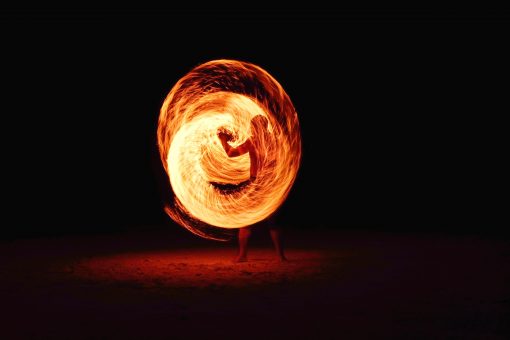
Learn to work with fire-based emotions and you can use it to develop inner-strength. Think of your internal fire as the flame of a hob cooker or campfire you can use to transform something raw and potentially dangerous into something wonderful and delicious.
The ordeals of fire with which you have to overcome relate to being wronged, criticised or persecuted, events that provoke anger. But fire can also burn your ego and by accepting the reality of a situation with care means you have mastered fire.
Fire has trance-like qualities and watching the dance of flames can help you calm body and mind. Learn how to build a fire and become one with the movement of the flames. You could even try creating a power dance in your mind.
At home burn incense and relax your mind. Stop the internal chatter. If you meditate and can self-induce a trance-like state all the better. Imagine the flame within burning away all negativity.
Water is fluid and adaptable and dictates your ability to manage any given situation. This is often referred to as going with the flow. In ancient China, the element of water was said to be the Chi energy that flows through your body, and is helped through exercises such as Tai Chi and yoga.
Whereas fire and air relate to thoughts and emotions, the element of water tests your ability to be fluid and adaptable in any given situation. We are confronted with circumstances on a daily basis, some of which are new experiences that present a challenge…
..and in many situations, you need to adopt the Bruce Lee philosophy of “Be water my friend!”
Japanese writer and researcher, Masaru Emoto demonstrated how wonderful or harmful we can be for one another in his experiments with water crystals and the now-famous rice experiment.
In his experiments, Dr Emoto concluded that when you direct positive energy towards water it forms geometrical patterns that are natural. Negative energy, on the other hand, disfigures the water.
When Dr Emoto submerged rice in jars of water and channelled positive or negative energies towards each one, the jars that received hate and the jar that was ignored rotted. The jar that received thanks and gratitude, on the other hand, remained fresh and healthy.
Whilst Dr. Emoto’s evocative rice experiment as been rubbished as untrue and unscientific, the message is none-the-less poignant: when you ignore someone, insult them or direct another form of negative action towards them, they will feel rotten inside.
Negative feelings are unhealthy and can lead to illness. Poor emotional states that cause disease is not pseudo-science that can be dismissed.
You will probably know from experience that when someone is negative towards you, it makes you feel bad inside. They can also create tension and ill-feeling on the outside.
The Gilead Institute of America, together with many other scientific researchers, are beginning to understand that you mind and actions by others towards you can cause illness.
To work with water, learn to understand how water works as it takes on many different mutations. It can flow gently down a stream, or tumble in a rage along a river.
The sea rolls gently against the shore or crashes against the rocks. Here we see the yin yang expression of duality in the nature of water – everything that exists has a polar opposite. Sometimes you have to be forceful, other times gentle.

Because water is also adaptable, harnessing its influence is essential for the purpose of self-development. When you put it in a vessel such as a jug or a bottle, the water changes shape and fits perfectly to the form of the vessel. This is symbolic of day to day life whereby we have to adapt to any given situation – the flow of energy should be like the flow of water.
Water is also used for cleansing and, whilst bathing, ancient shamans ask the water to wash away their sins, worries and problems. The next time you take a bath or shower, take a moment to let the water wash over you, feel the touch of it against your skin and ask for it to cleanse you.
Earth is commonly referred to in myth as Mother Earth – the bringer of life who nurtures the child. The child is symbolic of the creation you manifest through thoughts and actions.
In esoteric wisdom, Earth relates to the body. If you do not look after yourself and are unfit or unhealthy, it becomes more difficult to build other energies created from the three other elements.
Ordeals of Earth relate to the physical world, worries that are holding you back, tasks and events that are weighing you down or obstructing your path. People that are preventing you from achieving your goal.
But these types of ordeals are purely tests to determine whether you can move to the next level of consciousness. They test your perseverance and ability to overcome hurdles.
Like most Mother’s, Earth takes a lot of shit from her children, but like manure helps flowers grow, dumping things you don’t need on Mother Earth can help you grow.
Lay face down on the ground and unburden yourself of all your woes and worries, then be silent and listen to what Mother has to say. The noises you hear deliver a message.
Also when you eat, be aware of the taste and texture of the food you are eating. Do not be distracted by TV, music or conversation. Eat silently and slowly. Food is sacred to the body, without it we have no energy. So appreciate food and eat what is healthy for your body.
Ancient cultures typically used wild animals to symbolise earth. In Andean cultures, for example, the Puma represented the physical plane together with the strength that is physically and mentally required to handle inconveniences life throws at you.
You can learn to work with Earth through visualisation exercises whereby you shape-shift from one animal to another. Identify animals from different cultures around the world that represent Earth and the strength you need.
For example, in Nordic traditions there is a wolf, the sphinx in Egypt, leopards in African myth, and the Puma in ancient Andean cultures.
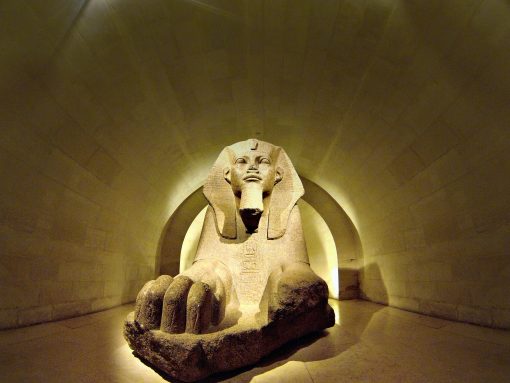
Also look towards myth for other land animals such as the snake, crocodile, bear, rabbit etc and learn how to shift-shape from one to the other. Develop a relationship with the spirit of the animal.
In ancient traditions, the dragon represents all four elements; the claws dig into the earth, they fly through the air with wings, breathe fire and have scales like a fish, thus we have water. The dragon is still prominent in modern-day China.
Finally, learn about fertility magic, or sex magic. This is secret wisdom and reliable information is difficult to find so, like me, you will have to experiment and explore with tantric sex – so have fun learning how to use this tool!
But the principle behind fertility magic is the ability to plant seeds and nurture them to fully blossomed fruit. You create the things you want in life – just as Mother Earth does.
The fifth element embodies all other four elements and in ancient scriptures symbolises the psychological and emotional qualities we have to adopt in order to develop our understanding of life.
By mastering the four elements in your emotions and actions, the fifth element emerges in your conscious mind and automatically takes control of any situation.
For example, if you find yourself confronted with antagonism, you will not become angry or aggressive yourself. You will have learned to control your fire by dowsing it with water and going with the flow without negative attitudes affecting you.
|
Element |
Positive characteristics |
Negative characteristics |
|
Fire |
High self-esteem, enthusiastic, courageous, passionate, natural leader, productive, self-respecting, creative, original, resourceful |
All-consuming, egotistical, irritable, quick to anger, macho, obsessive, jealous, snobbish, critical, gluttonous |
|
Air |
Progressive, can see the big picture, flexible, curious, penetrating, independent, adventurous, intellectual |
Anti-social, sloppy, uncaring, gossipy, undependable, fickle, dishonest, unpredictable, flaky, slow, |
|
Water |
Self-aware, tranquil, adaptive, empathetic, modest, devoted, reflective, authentic, integrating, co-operative |
Apathetic, low self-esteem, stagnant, cowardly, jaded, sexually addicted, naïve, lazy, self-doubting, needy |
|
Earth |
Respectable, hardworking, pay attention to detail, stable, reliable, cautious, punctual, practical |
Superficial, restrictive, stubborn, hesitant, boring, serious, compulsive, objective, uncreative, mentally dull |
Become tranquil by becoming more self-aware and reflective. Once the flames are out and the water has dried, you will be better respected by others – the element of Earth, where all creation comes into fruition.
Similarly, if you lack courage or self-esteem, heat these negative water elements with fire. Be passionate, courageous and creative.
You can increase the power of each of the elements through visualisation exercises. I have described some useful exercises you can do to work with each element, but you can also imagine your body filling with whatever energy you want to provoke.
Let the element move around your body, visualise it passing through each of your chakras and try to feel the energy moving through your body. If you are well-rehearsed at meditation this should not be a problem.
Once you can sense the new quality in you, practice using it in your everyday life. If nothing occurs naturally, create a situation where you need to employ your newly emerged and positive character trait.
Scientists that do attempt to explain the nature of consciousness are criticised for their “pseudo-scientific views and labelled cranks. It’s a harsh criticism – especially when the daggers are thrown by deluded minds.

Ancient sages seemed to have the nature of consciousness nailed thousands of years ago. Modern man seldom listens to the timeless wisdom hidden in myth and scriptures.
To be fair, we are not being provided with rational explanations about the real meaning woven between the fabrics of world mythologies. Instead, academia write-off ancient wisdom as “primordial” view of the world.
For modern thinkers to consider themselves intellectually superior to our ancient ancestors is shallow, deluded and arrogant.
With such materialistic and short-sighted views, it is little wonder that the planet is falling apart at the seams?
The wise men of old were more far more connected to nature than we are today. As a consequence, they recognised their own true nature.
This is liberation; mentally, emotionally and spiritually.
To help other people understand the nature of consciousness, wise Indian sages divided human nature into three categories of personality.
They separated the three modes of material nature into three parts, collectively known as The Three Gunas; sativa, raja and tamas.
Bhagavad Gita 14:20 | When the embodied being is able to transcend these three modes, he can become free from birth, death, old age and their distresses and can enjoy nectar even in this life.
In essence, the three gunas are primal energies of Cosmic Intelligence that encompass matter, life and mind.
The qualities of energy that emerge from the Unconscious engage in patterns of interplay that influence thoughts, emotions and actions.
Eventually, the subtle qualities of nature manifest in the conscious mind and the subconscious mind. Observing the nature of your conscious thoughts, emotions and actions enable you to identify and eliminate traits, attitudes and beliefs that do not serve you.
They form the spectrum of consciousness which eventually develops as physical and spiritual experiences and help us to understand how the mind functions.
Nature forms through various forces of consciousness and can either mature into wisdom or take up roots as ignorance. Human nature is affected by the clarity we obtain from enlightened thoughts, or the delusions that are programmed by society.
The latter typically result in negative experiences and a poor quality of life. Because energy carries information, the information you absorb influences your view of the world.
“There is no matter that does not carry information and energy. Similarly, there is no energy that does not carry matter and information. And there is no information that is not carried by matter and energy. Matter and energy are the carriers of messages or information.” ~ Dr. Rulin Xiu, Tao Science: The Science, Wisdom, and Practice of Creation and Grand Unification
The manifestations of these subtle energies are determined by our choice of lifestyle. We are naturally prone to error, but unless we are willing to understand and atone for our errors we are more susceptible to harm, confused thinking and physical illness.
To improve your quality of life, you need to identify and eliminate the experiences that cause you problems; stress, grief, frustrations etc.
Sometimes, these pain points will be caused by other people. Sometimes they will be caused because of your attachment (habit, addiction, weakness etc) to a person or situation. Mostly they are caused by your reaction to the circumstance.
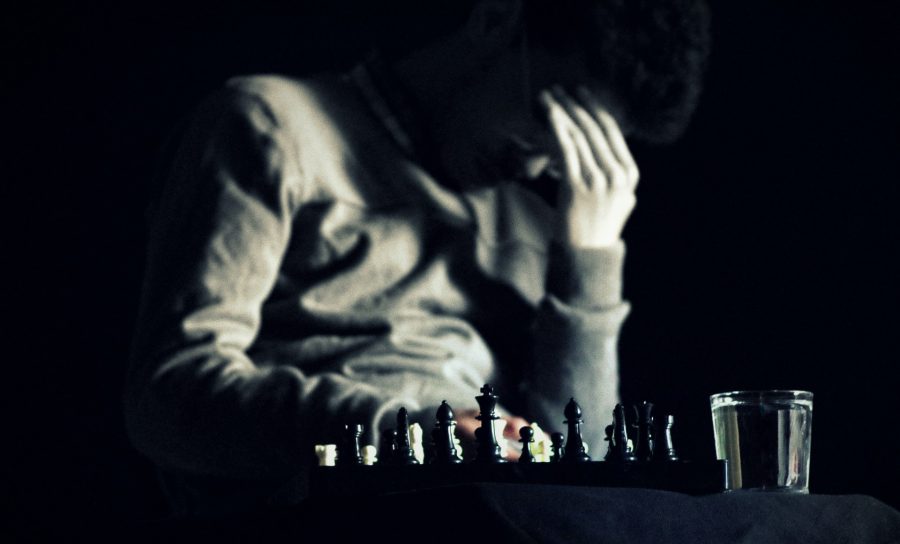
For self-conscious individuals that actively look to improve their lifestyles and attitudes, promote positive energy on a daily basis and acknowledge their faults, will be rewarded with a rational, calm and peaceful mind.
The three gunas bind themselves to the ego which ultimately creates our personal nature.
These energies are then projected outwards from the internal world of the mind – which we are mostly unconscious of – into the physical world where it manifests as reality.
In general, the mind is unstable and fluctuating thoughts cause us to lose control of our emotions and actions. Negative energies also secrete toxic chemicals from the brain and cause illness.
It is therefore important to understand how energies appear in our conscious psyche. The ultimate goal is to identify habits that are self-harming. The challenge is to find the strength and willingness to change.
By altering or adapting our lifestyles and the choices we make in life, we can physically improve our nature and find the path to living in peace and harmony.
Rajas, Tamas and Sattva.
Rajas and Tamas are moderate to poor habits that are ultimately the cause of mental disharmony and agitation.
Sattva is a healthy and responsible way of living that result in a well-balanced nature of being.
Tamas is negative energy that creates obstructions, delusion and ignorance. It makes us lazy, insensitive, inert, attached, depressed, helpless, doubtful, guilt-ridden, bored, sad, apathetic, confused and dependent.
People that are prone to tamastic energies live unhealthy, chaotic lifestyles and thus have unstable mental health. They are typically unconscious of the effect their actions have on other people and tend to ignore their own problems.
The following natures come from tamas energy:
Tamas is often the result of psychological blockages that have rooted themselves in the subconscious which is then transferred to ego. Subsequently, the ego becomes your nature. But the ego is not your True Nature. it is a subconscious program that erects boundaries and prevents us from experiencing happiness and abundance.
People that suffer from tamasic energy become repressed, stagnant and tend to blame others for their own problems. When they are ill or experience problems, they do not seek proper help and hope the problem will just go away.

In short, tamasic energies create blockages in your inner world and your outer world! If you associate with any of the above symptoms, you need to change the way you react to your circumstances.
Rajastic people are energetic and motivated to succeed, but oftentimes will burn themselves out. Too much activity and turbulence upsets the equilibrium of balance.
The nature of Rajas is a longing for recognition and an attachment to worldly possessions which compels us to seek an affluent lifestyle. Symptoms include anger, euphoria, anxiety, fear, irritation, worry, restlessness, stress, courage, rumination, determination and chaotic lifestyles that do not allow you to be still.
Although Rajas energy is stimulating, it evokes desire and passion which compels us to seek happiness on the outside rather than the inside. The distortion of Truth creates a false impression of the world which ultimately leads to pain and suffering.
Whilst it is true that Rajastic people can be materially successful in the physical world, because they are not conscious of their spiritual nature, their minds are often restless and emotionally unstable.
Rajas nature can be detected by the following qualities:
Although the attributes and qualities of Rajas are both good and bad, we should look to balance our energies with better living in order to bring about the best qualities of Rajas.
If you do everything by moderation you can improve Rajas, but there is also a need to adopt more Sattvic ways of living in order to purify the negative energies that exist in Rajas.
Ayurvedic practitioners maintain that the Sattvic way of life brings us in tune with our inner-self and helps us to discover our True Nature. It cultivates purity and peace of mind which creates harmony and stability in our lives.
Sattvic energy starts from within and moves upward to connect us with higher consciousness. This is the Cosmic Intelligence where we find our True Nature.

Sattva energy promotes the best qualities of our nature and enables us to draw positives from negative situations. We are more consciously aware of our thoughts, emotions and actions which give us more control our environments.
Sattavic people are generally more creative and healthy because they cut off the negative roots which grow as erratic behaviour and disease. Not only do they look after themselves physically and mentally, but they are also generally more open-minded. When something bad happens in their life they strive to understand what caused it. Life is always a learning curve.
The qualities of Sattva are:
It should be noted that we should not bind ourselves to the virtues of Sattva energy, otherwise we upset the balance of duality. However, if your nature is predominantly Tamas or Rajas, try incorporating Sattva into your life.
The first of moving out of Tamas and into Sattva is to do more exercise, eat less red meat, consume organic and healthy foods, drink less alcohol, caffeine and soda and abstain from taking intoxicating substances.
We should also respect the nature and opinions of others and try to bring more harmony into our lives. Sattva gives us the clarity of vision to alter our perceptions which allows us to find peace of mind.
The mind cannot be freed from chaos and clutter until we bring our energies into balance. By using the three gunas as a guide, our modes of nature will fall into place and ultimately improve our quality of life.